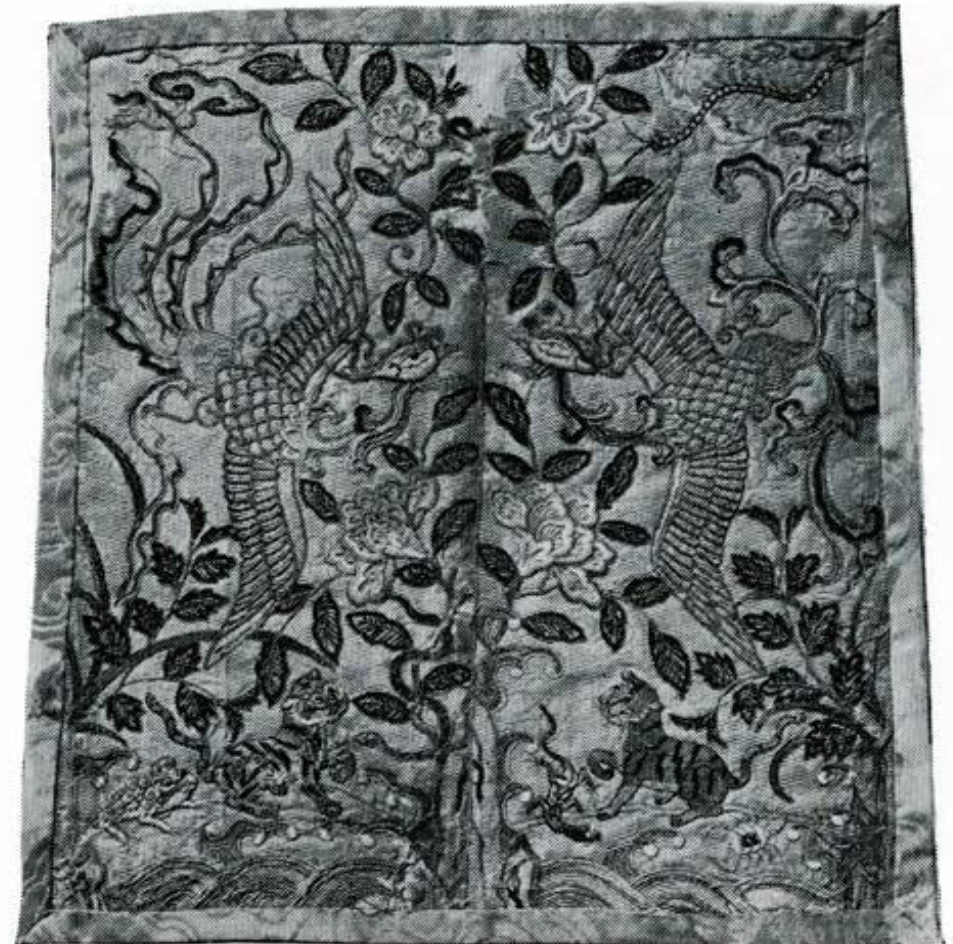
Museum Object Number: 52-23-3
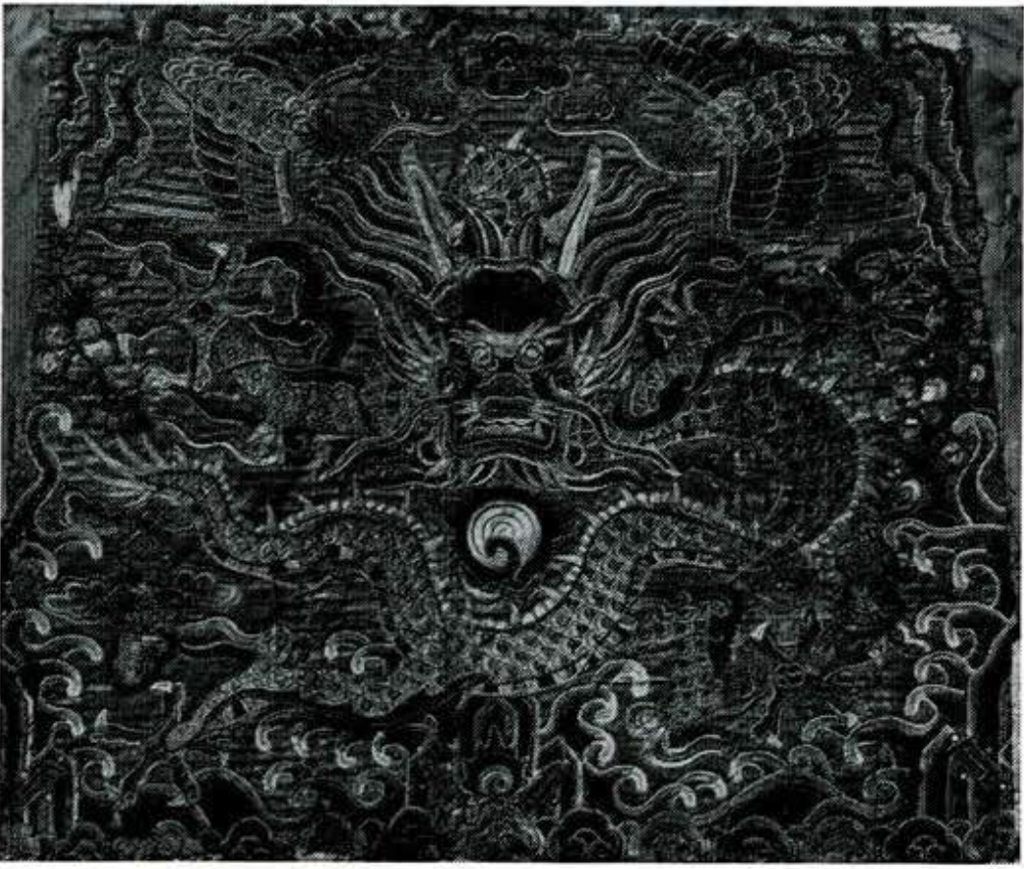
Museum Object Number: 52-23-2
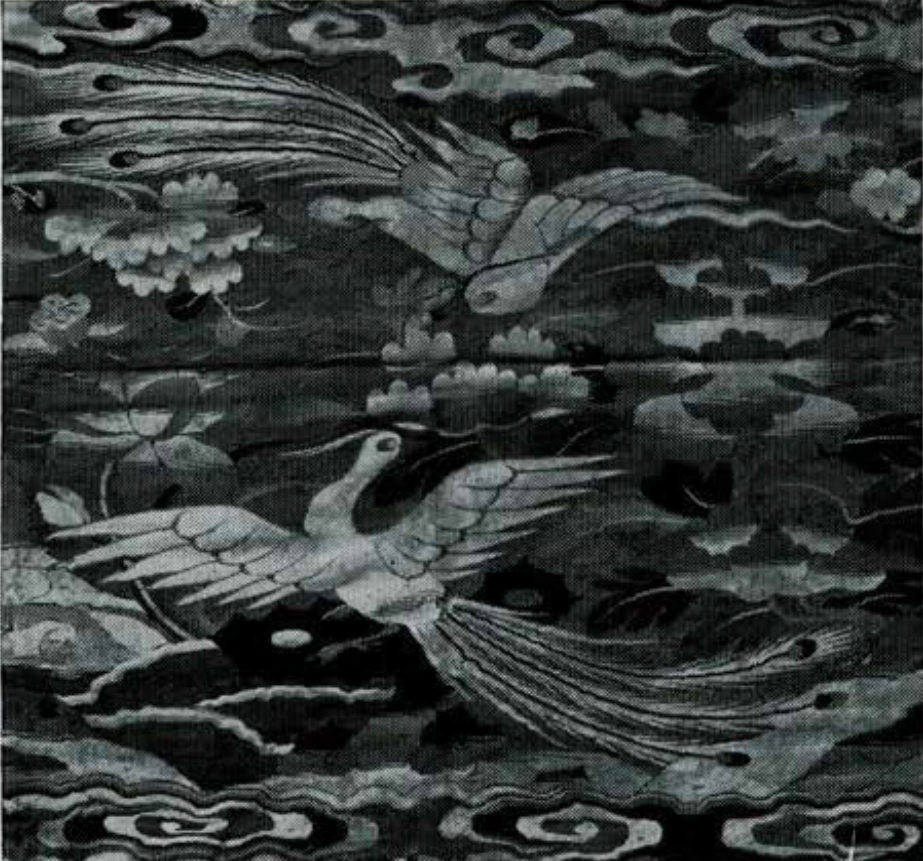
Museum Object Number: 52-23-6
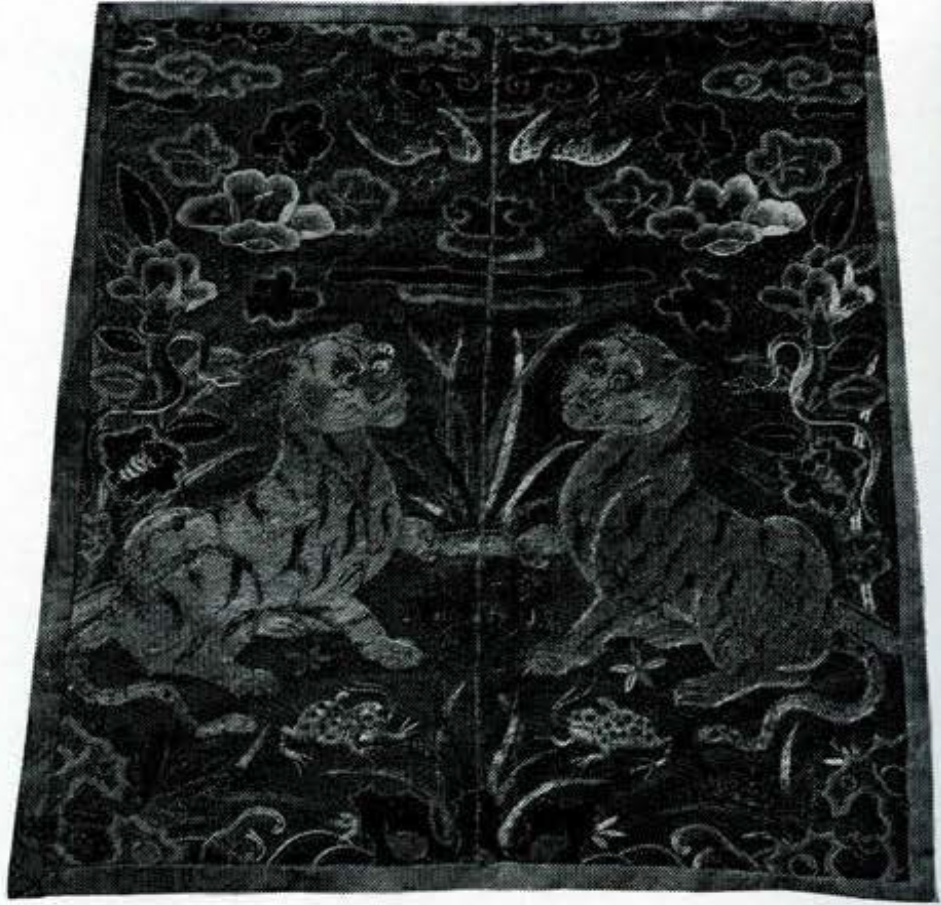
Museum Object Number: 52-23-5
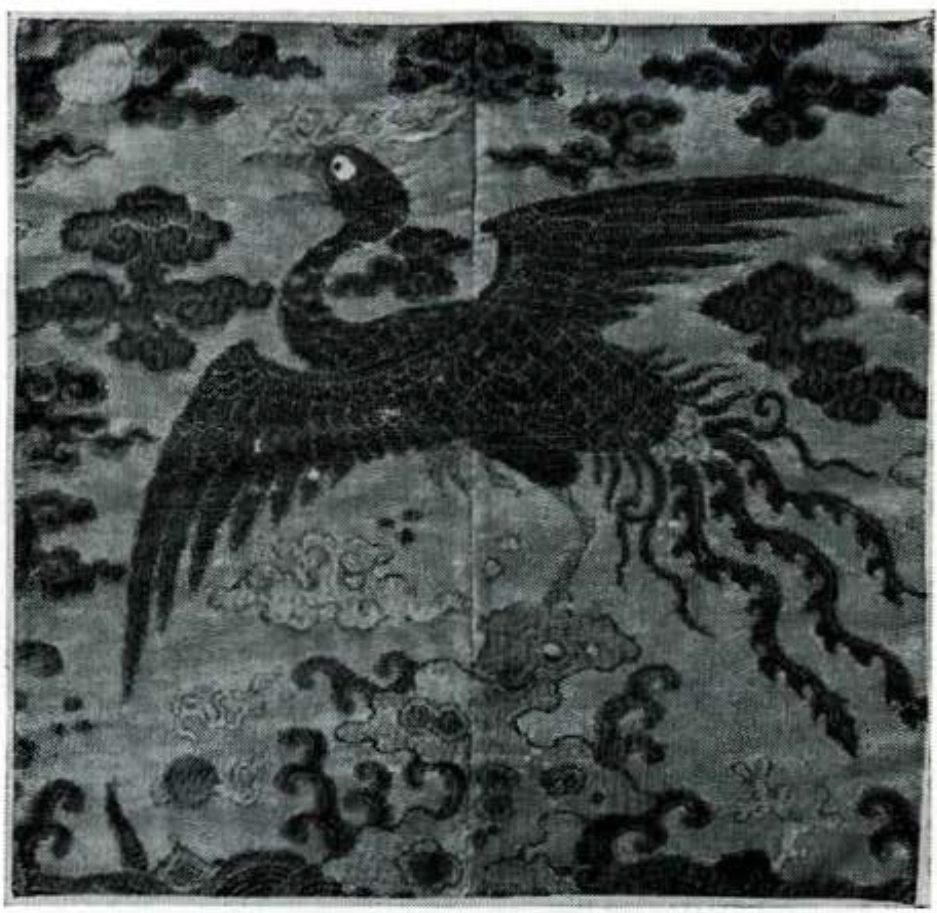
Museum Object Numbers: 52-23-10A / 52-23-10B
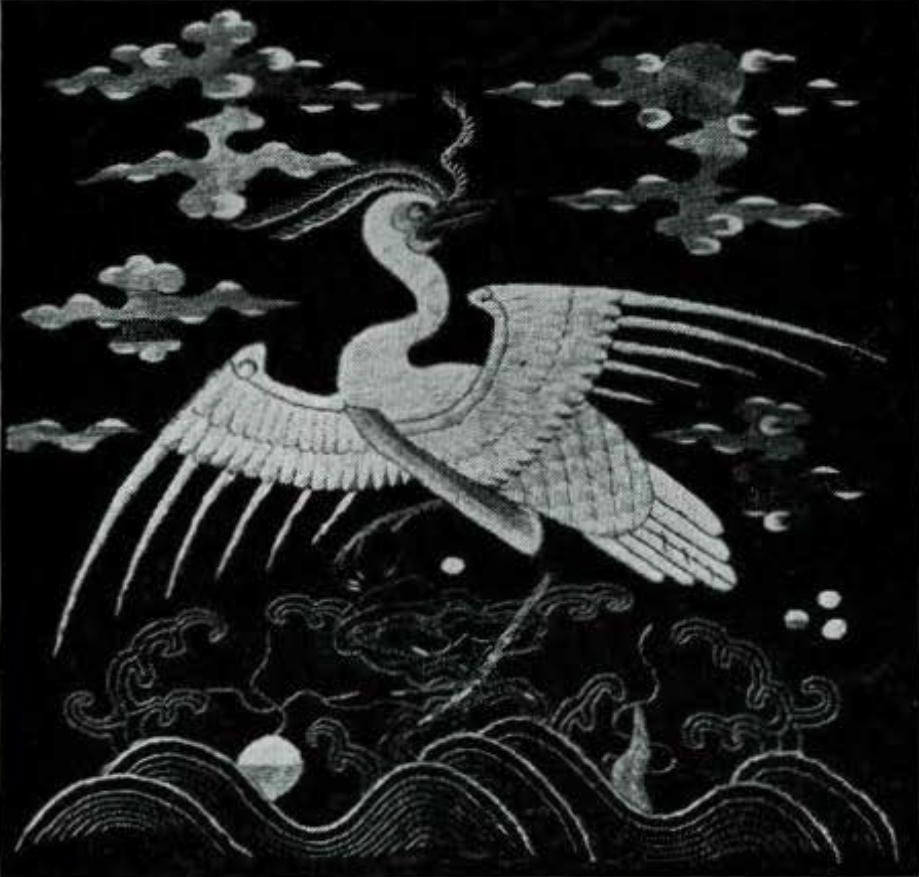
Museum Object Number: 2-23-11A / 52-23-11B
A. MING BADGES
- Circular medallion from the robe of a Ming Emperor, showing a powerful winged dragon (ying) pursuing its sacred pearl. Flowers in background. Magnificently embroidered in satin stitch, against a background of horizontal strips worked vertically in satin stitch. Late 16th or early 17th cent. Illustrated in Fig. 17. Museum Object Number: 52-23-1
- Panel from the robe of a Ming Empress, distinguished by the pair of Chinese phoenixes along with the five-clawed, facing dragon. Background patterns of gourds and cherry blossoms indicate that it was intended for use at the New Year Festival. Finely embroidered in the same technique as the previous one. Jewel symbols on rocks below. Possibly 16th cent. Illustrated in Fig. 2. Museum Object Number: 52-23-2
- Ming princess’s badge, with a pair of Chinese phoenixes. Made for the Tuan Yang Festival, on the fifth of the fifth month, this contains all the symbolic elements required by the occasion: tigers, artemisia leaves, and other auspicious plants, as well as the Five Poisons: (flying) centipede, toad, snake, scorpion, and lizard. Superbly embroidered in many different stitches which show Ming versatility, on patterned gauze (for a thin summer robe). Possibly 16th century. Illustrated in Fig. 1. Museum Object Number: 52-23-3
- Ming courtier’s Tuan Yang Festival badge, with a pair of tigers laid in gold thread, and the Five Poisons with the traditional auspicious plants, variously embroidered against a pattern-darned background. Probably 17th cent. Museum Object Number: 52-23-4
- Ming courtier’s Tuan Yang Festival badge. The same subject, somewhat differently rendered. Given the same problem, the artist (or artists) has handled the subject with variations. Probably 17th cent. Illustrated in Fig. 4. Museum Object Number: 52-23-5
- Ming slit tapestry (k’o-ssu) square for an unclassed official (below the ninth rank). Two Paradise flycatchers, rocks, waves, and peony symbols, arranged on a background of fine gold. So well woven that the square is reversible, both sides exactly the same. Silk warp on hemp weft. 15th or 16th cent. Illustrated in Fig. 3. Museum Object Number: 52-23-6
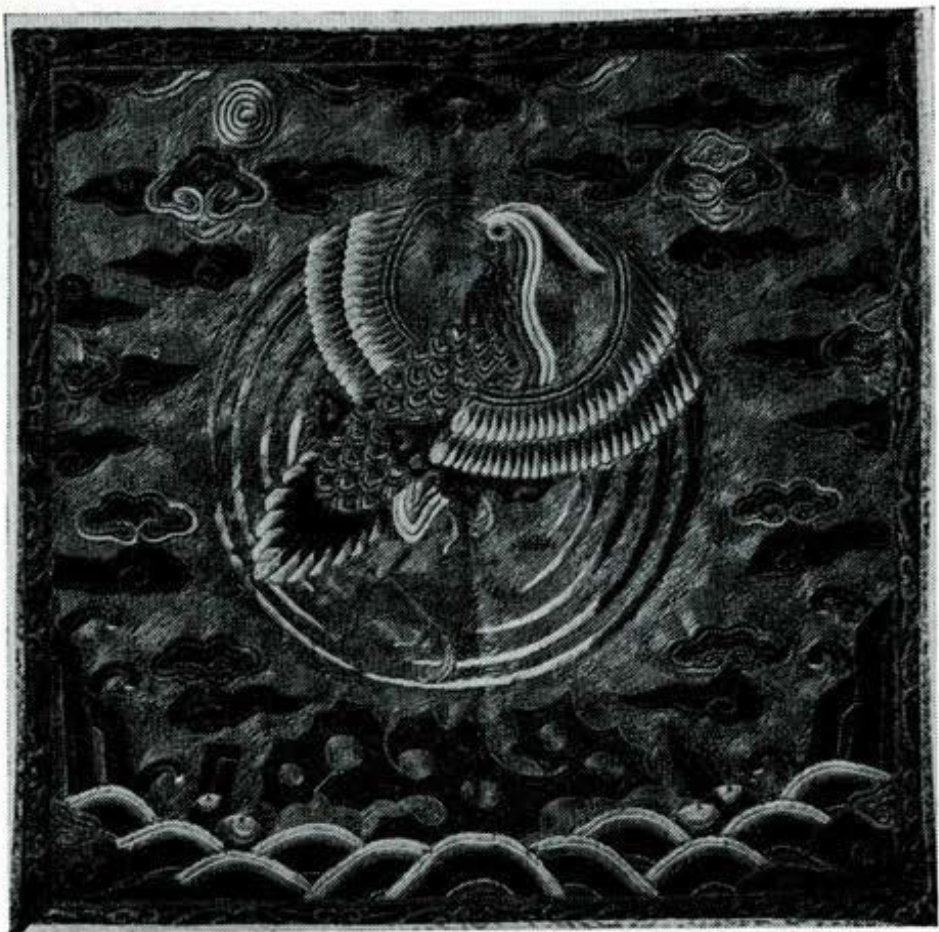
Museum Object Number: 52-23-13
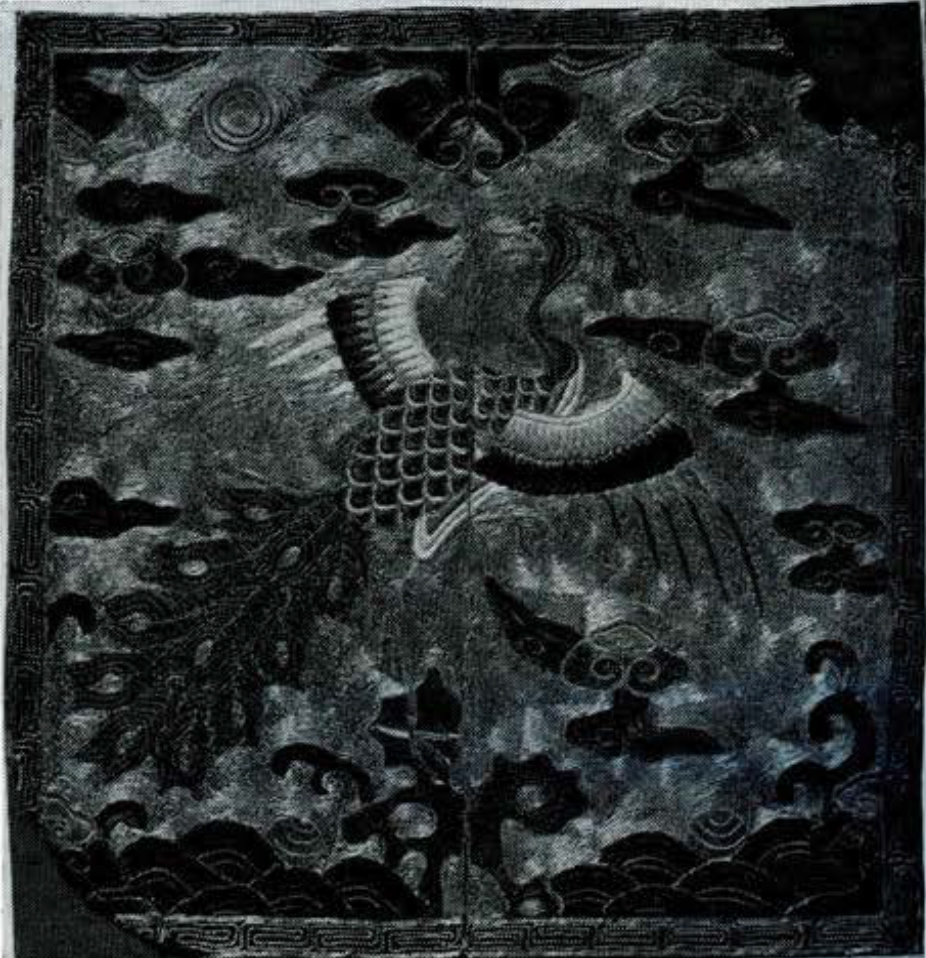
Museum Object Number: 52-23-9
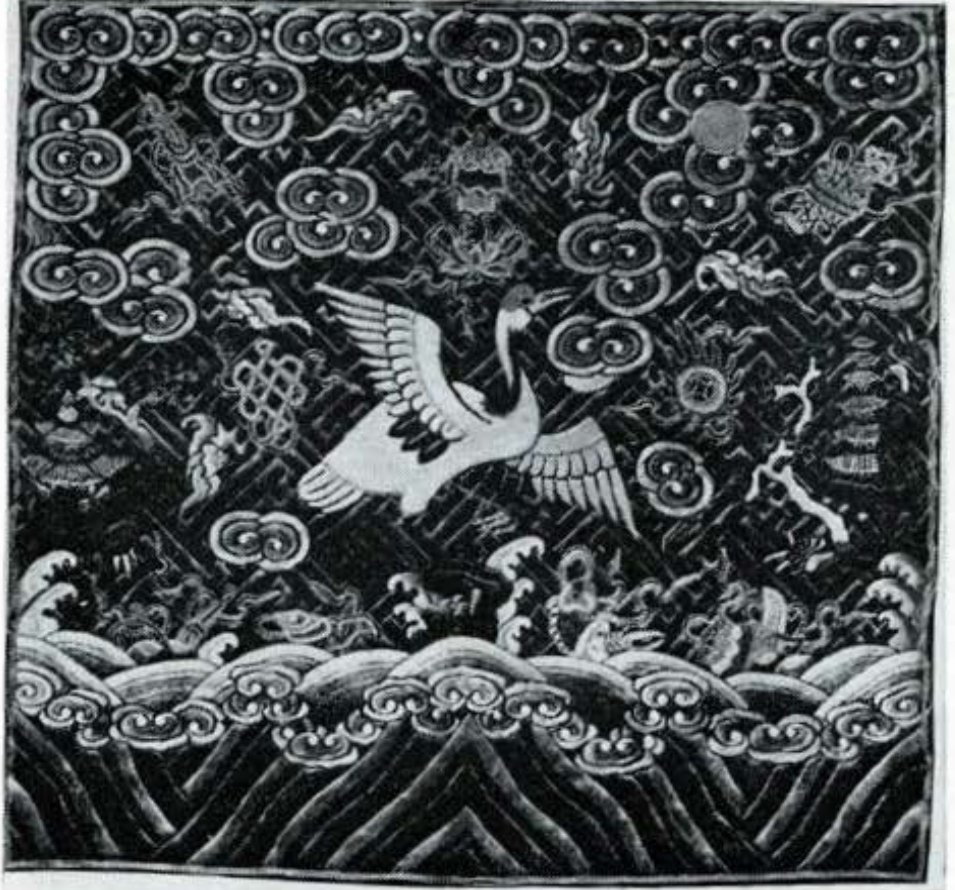
Museum Object Number: 52-23-18
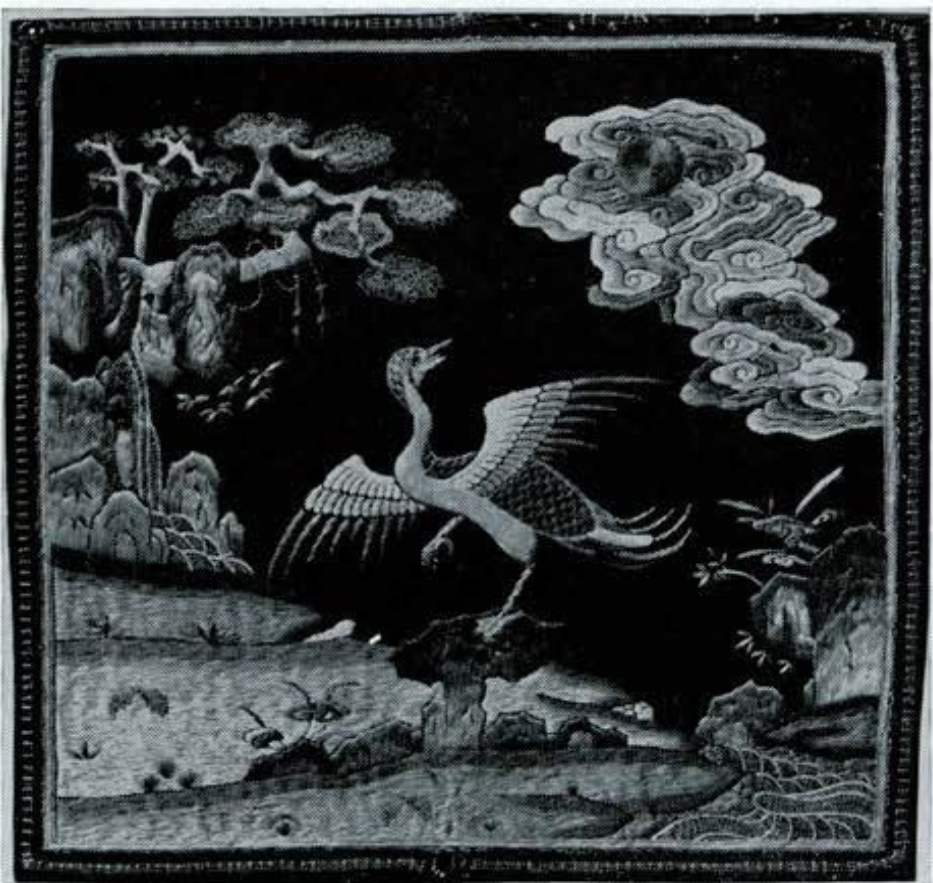
Museum Object Number: 52-23-26
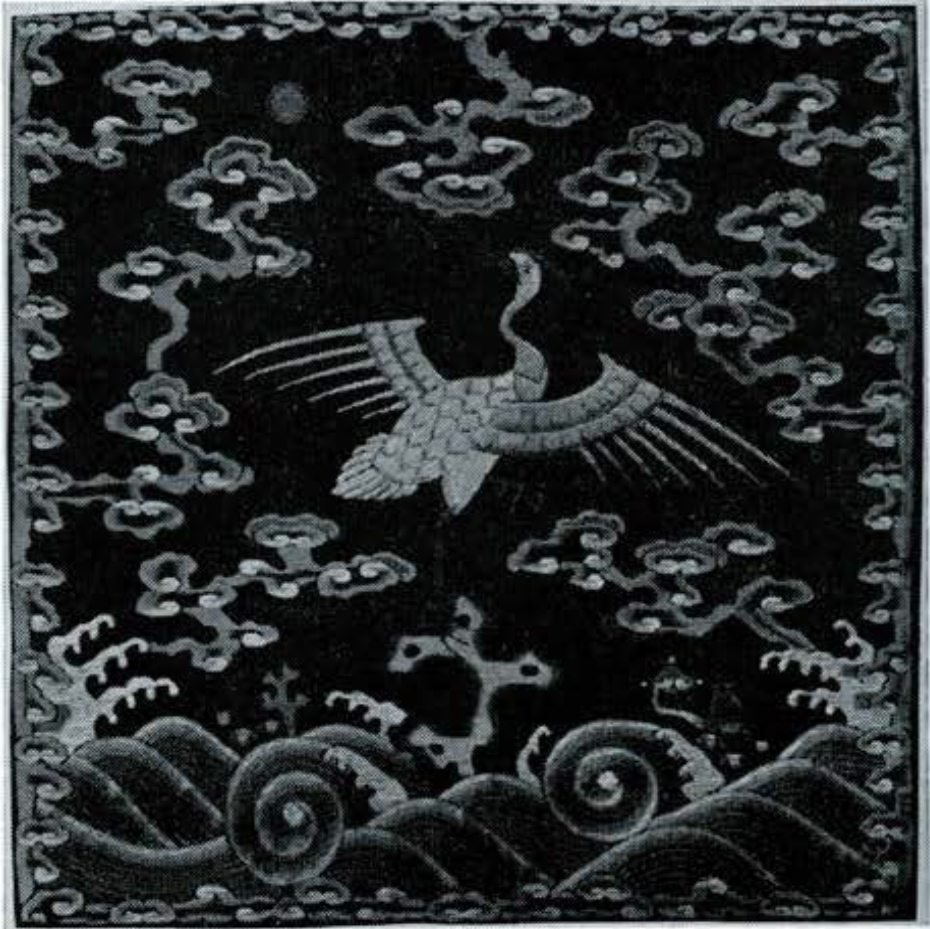
B. EARLY CH’ING SQUARES
- Part of a Golden pheasant medallion, probably from an early Ch’ing noble- woman’s “pheasant robe,” rather than an emblem of rank. Two birds, one flying, one perched on a rock, with peonies and other flowers massed in the background, arranged in a circle, with four conventionalized bats filling out the corners of a square. Done in laid satin stitch with couched gold outlines, on coarse gauze. Museum Object Number: 52-23-7
- Early Ch’ing first rank civil official’s crane square. Done in silk tapestry, at a time when this technique seems to have been an imperial monopoly, so probably made to order as a present from the Emperor to one of his highest officials. Jewel symbols in sea. Later 17th cent. Museum Object Number: 52-23-8
- Early Ch’ing third rank civil official’s peacock square. In satin stitch on gold background (irregularly laid), with Greek fret border in couched gold threads. Pearl symbols in sea. Damaged in two corners. Later 17th cent. Illustrated in Fig. 8. Museum Object Number: 52-23-9
- Early Ch’ing fifth rank civil official’s Silver pheasant squares (pair). Brocaded with threads of gold, colored silk, and spun peacock feathers. Though originally woven for a Ming style robe, a re-sewn seam on one shows that they were probably later adapted for a Manchu jacket which required a split front square. Made about 1645. Illustrated in Fig. 5. Museum Object Number: 52-23-10A / 52-23-10B
- Early Ch’ing sixth rank civil official’s egret squares (pair). Bird and clouds in satin stitch with some Bokhara couching; couched gold threads for bordering lines, breaking waves, and outlines of the rock. (The rock once was covered with couched peacock feathers, now mostly gone). Done in blue-black satin, with no border. Jewel symbols in sea. Made before 1652. Illustrated in Fig. 6. Museum Object Number: 52-23-11A / 52-23-11B
- Early Ch’ing seventh rank mandarin duck square. In satin stitch on gold background, irregularly laid. Traces of former peacock feather couching. Jewel symbols in sea. Late 17th cent. Museum Object Number: 52-23-12
- Early Ch’ing seventh rank mandarin duck square. Bird, sun, and other details in satin stitch, on laid gold. Trimmings of bird, rock, and background of border formerly had couched peacock feathers. Bird contorted to form a circular pattern in the center. Symbols: book, rhinoceros horn, and pearls. Characteristic border of paired scrolls, partly damaged. Later 17th cent. Illustrated in Fig. 7. Museum Object Number: 52-23-13
- Early Ch’ing ninth rank civil official’s Paradise flycatcher square. An early 18th century survival of the familiar 17th century pattern, but smaller. Couched gold on regularly laid gold; formerly having peacock feather trimmings. Simple two-line couched gold border. The tail of three plumes was an early Ch’ing convention, later abandoned. Early 18th cent. Museum Object Number: 52-23-14
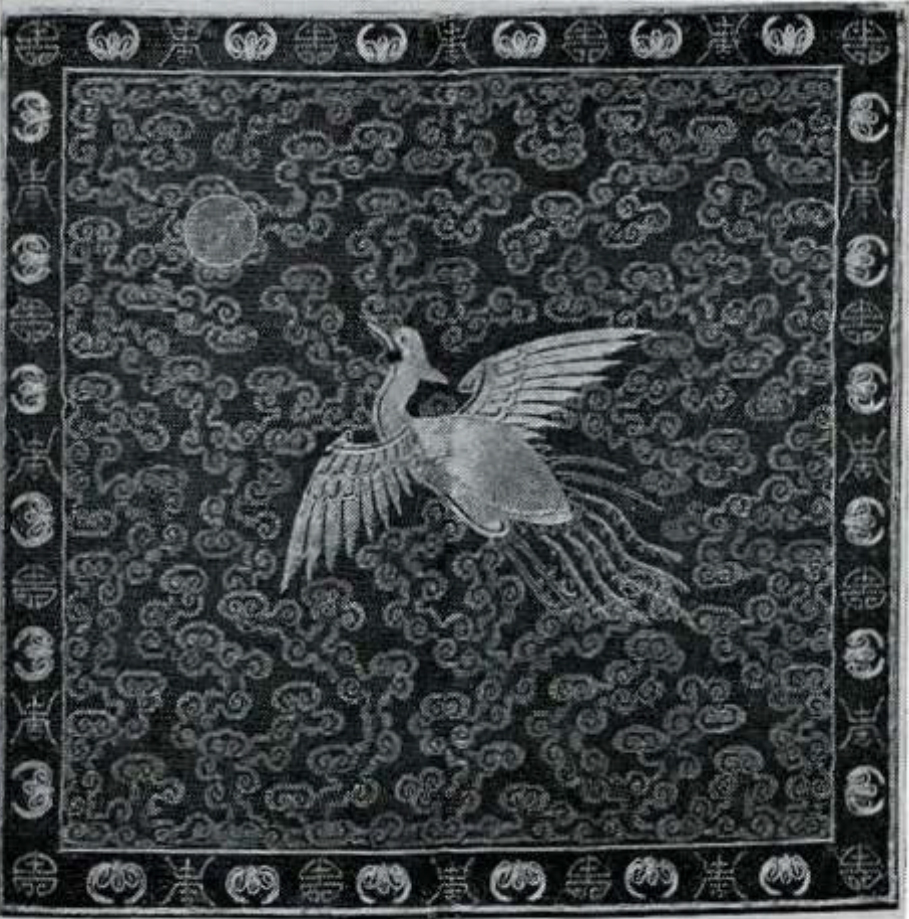
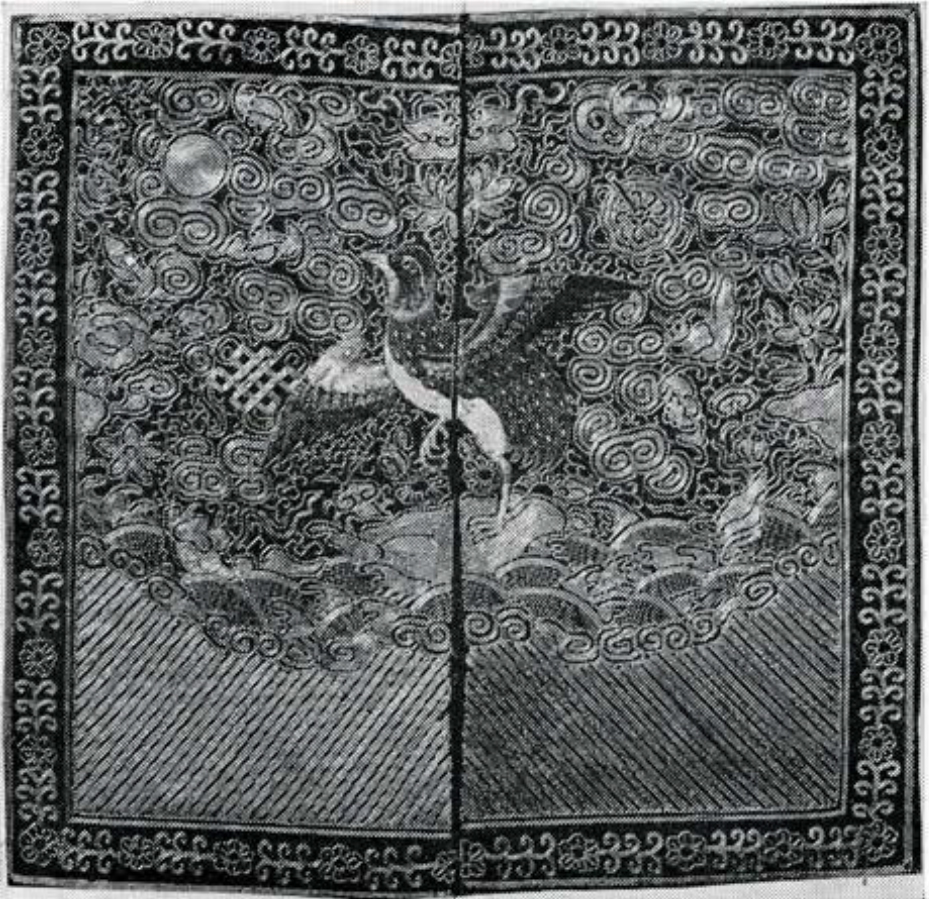
Museum Object Number: 52-23-58
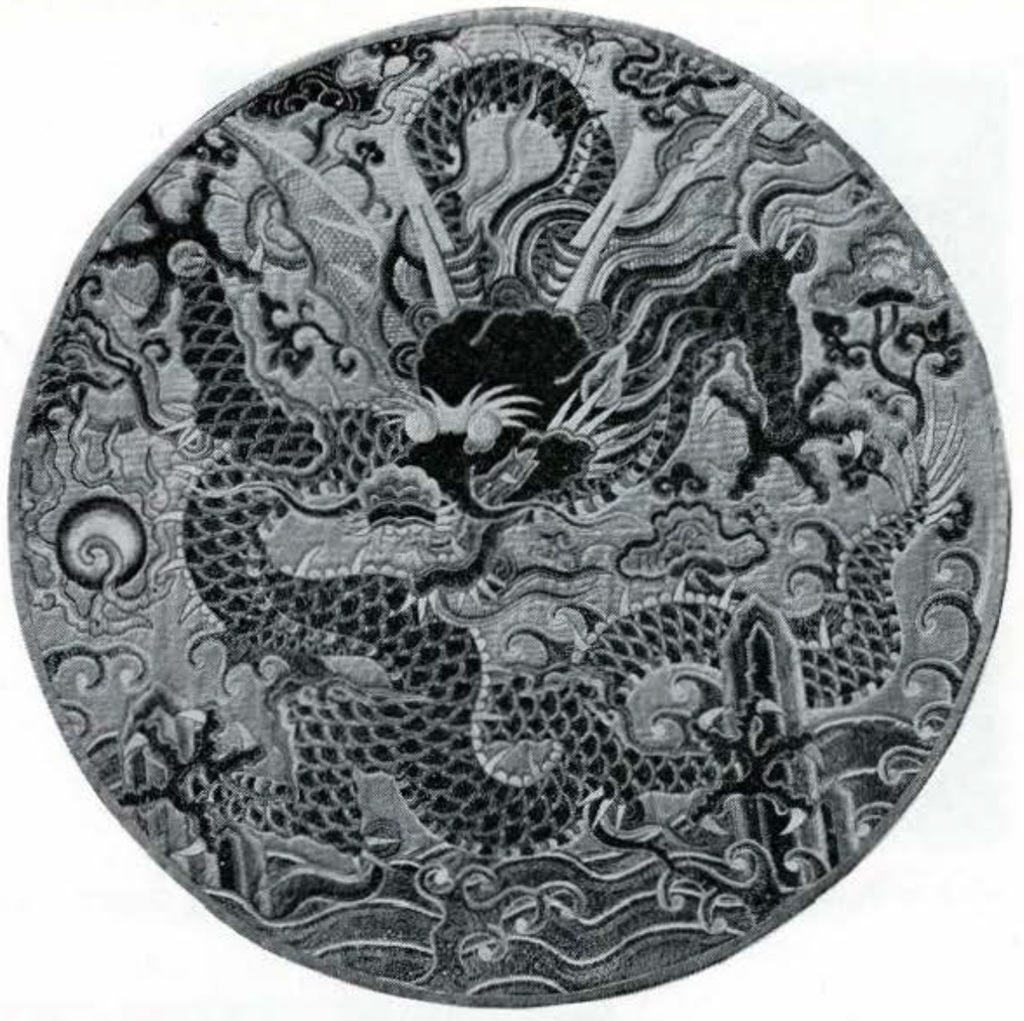
Museum Object Number: 52-23-1
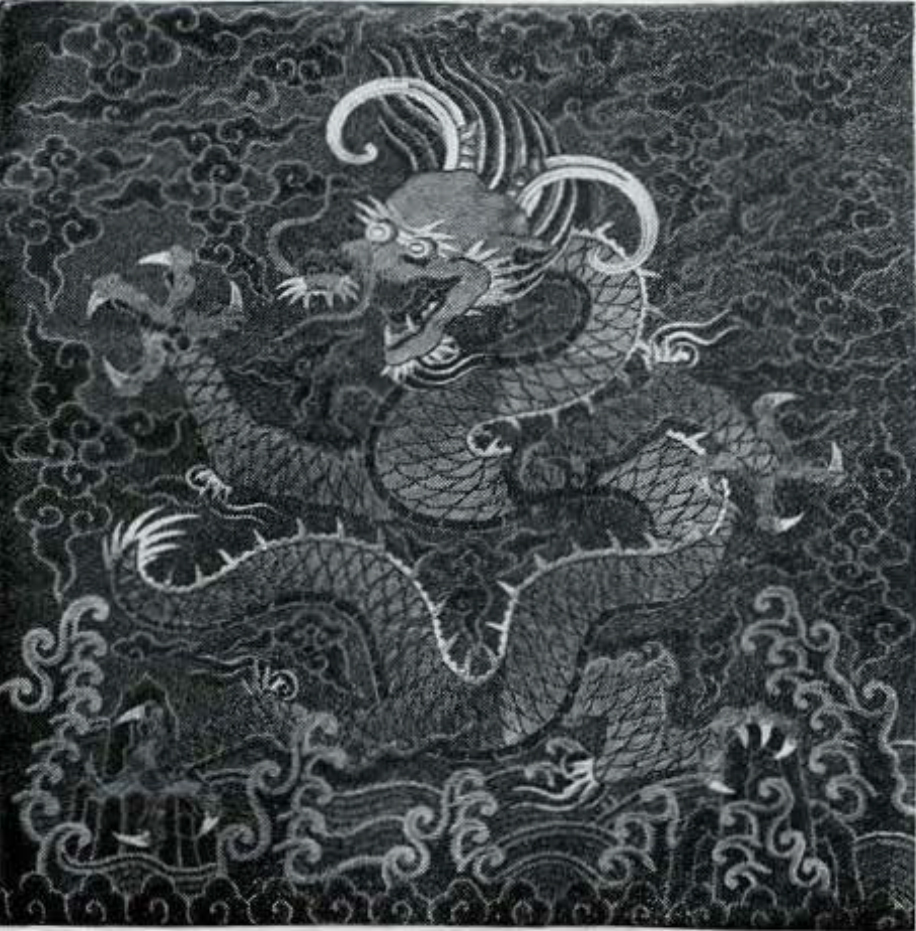
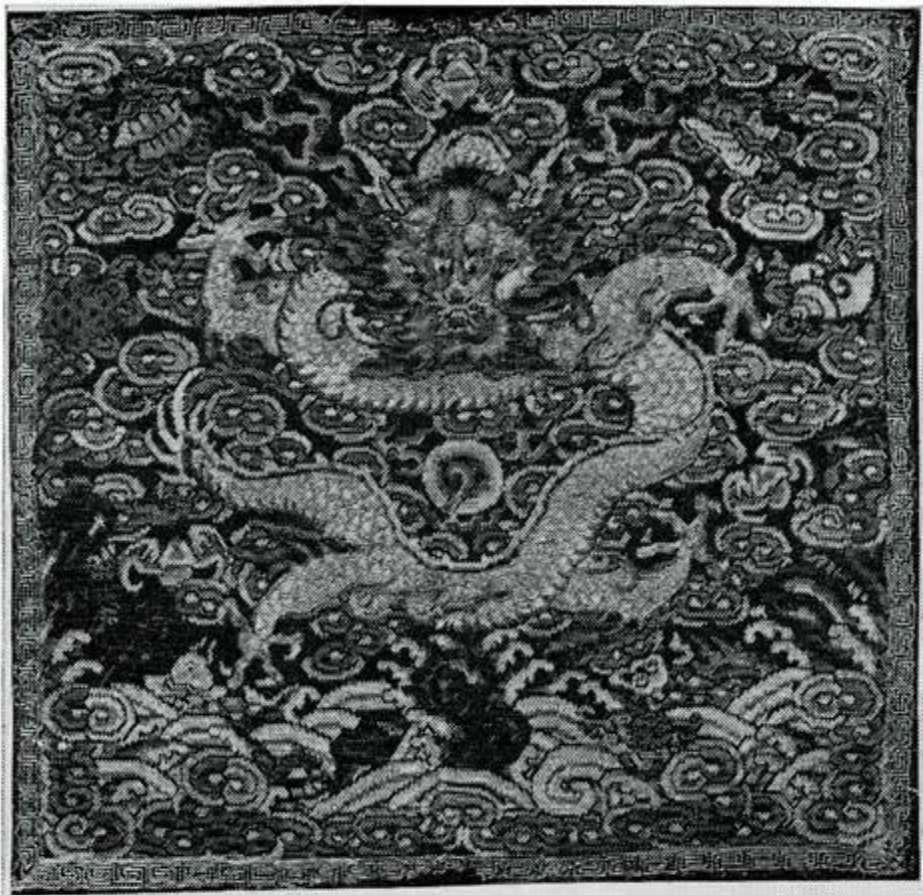
Museum Object Number: 52-23-69A / 52-23-69B
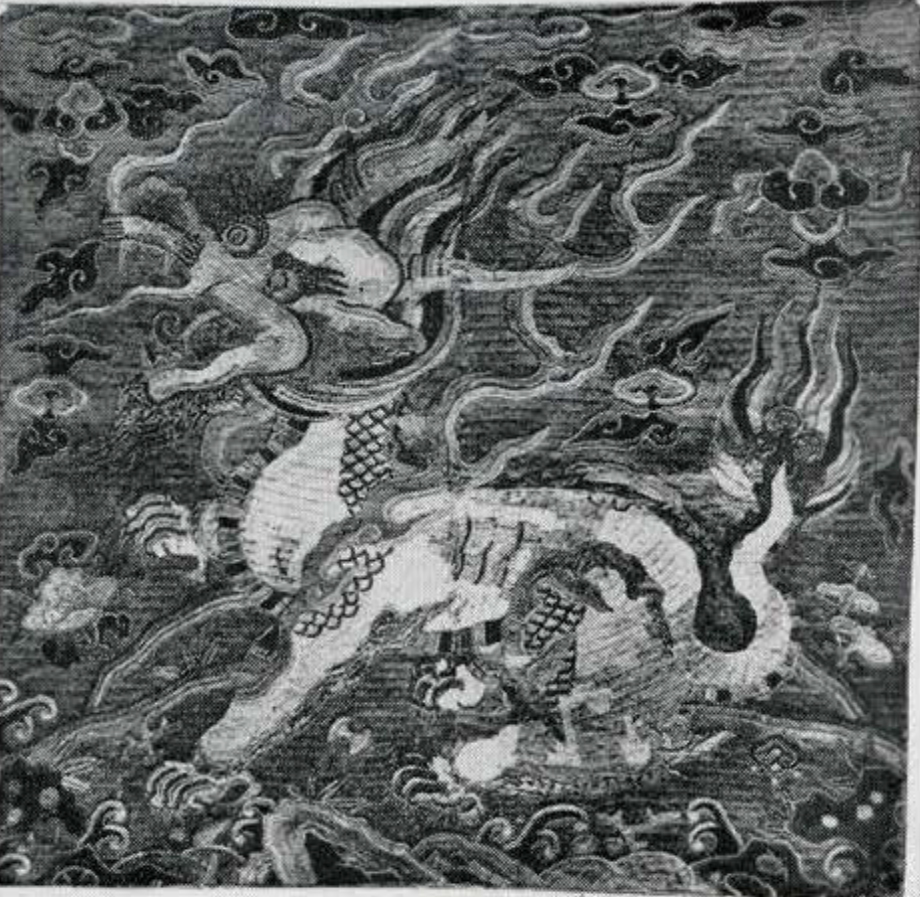
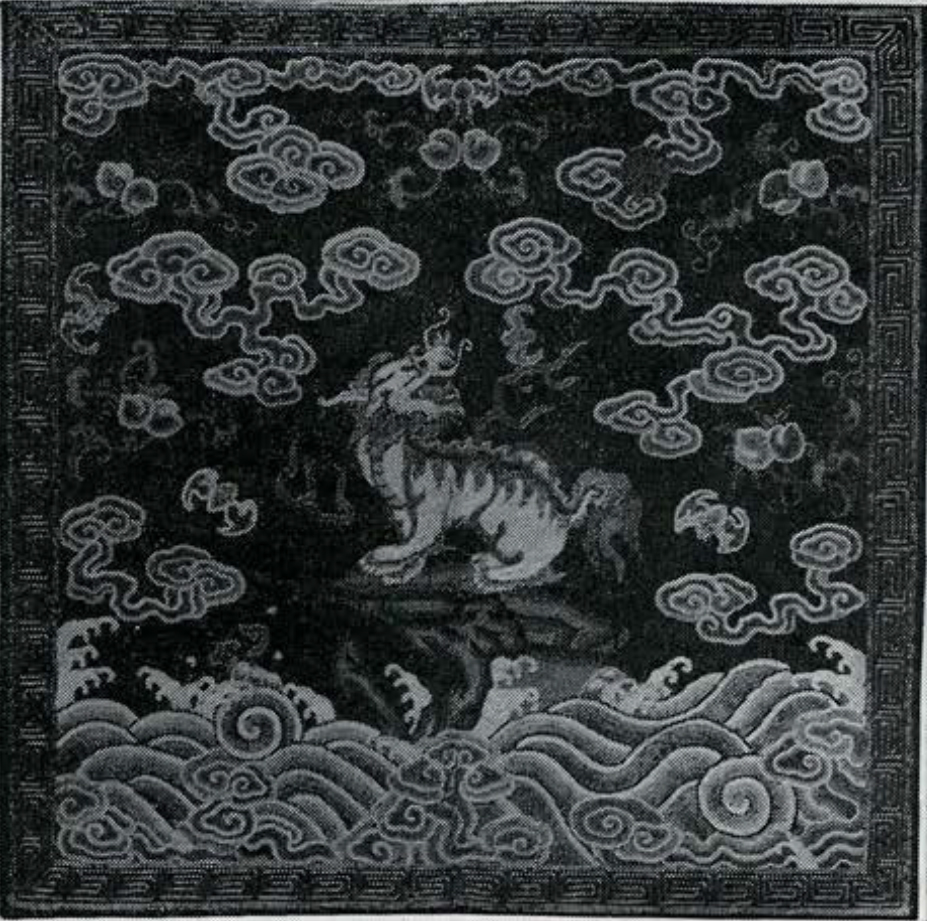
Museum Object Number: 52-23-66
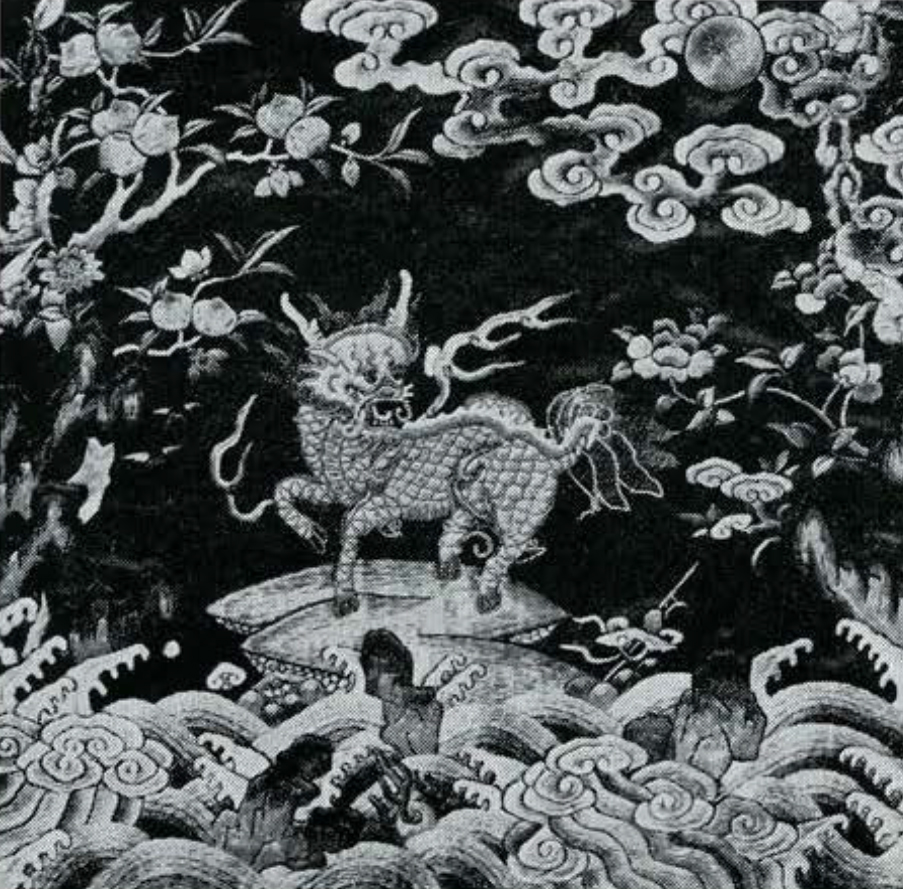
Museum Object Number: 52-23-71
C. MIDDLE AND LATER CH’ING BIRD SQUARES
- First rank crane square for wife of official. Satin stitch on blue-black satin. Symbols: pine, fungus, and bamboo and chrysanthemums, for longevity. Later 18th cent. Museum Object Number: 52-23-15
- First rank civil official’s crane square. Pattern in satin stitch, except for Peking knot for top of bird’s head and centers of flowers; on laid gold background. Symbols: peonies and marigolds, peaches and narcissus plants, two red bats, and lucky jewels in waves. Border of two couched lines in gold. Early 19th cent. Museum Object Number: 52-23-16
- First rank crane square for wife of official. Mostly satin stitch on blue-black satin; sun disc and waves in stem stitch. Symbols: pine and fungus of longevity; lucky jewels; three halberds in a vase (forming a pun on p’ing sheng san chi, “May you peacefully rise three degrees in rank”), and a ju-i scepter. Greek fret border. Later 18th cent. Museum Object Number: 52-23-17
- First rank crane square for wife of official. Bird, five (tawny) bats, clouds, rocks, waves, and background of swastika fret, in satin stitch. Top of bird’s head and accessory symbols in fine Peking knot. Symbols: the Eight Buddhist Symbols, jewel symbols, bell and scepter symbol; pines and fungus, pavilion and pagoda, on rocks at sides; li-shui (deep sea conventionalized) at bottom. Greek fret border. Late 19th cent. Illustrated in Fig. 9. Museum Object Number: 52-23-18
- Second rank civil official’s Golden pheasant squares (pair). Done in late k’o-ssu tapestry, with imported aniline dyes. Background has an all-over diaper pattern with many symbols: five bats holding symbols, the Eight Buddhist Symbols, Eight Symbols of the Taoist Immortals, and a border of alternating bats and shou characters; li-shui below. Early 20th cent. Museum Object Number: 52-23-19A / 52-23-19B
- Second rank civil official’s Golden pheasant square. Mostly in Peking knot, having outlines of couched white twisted cord, with a few details in satin stitch, on blue satin. Symbols: five red bats, peonies and fungus with bamboo, peaches and narcissus; and the Eight Buddhist Symbols in the sea. Border of red bats alternating with shou characters. Single, front square. Late 19th cent. Museum Object Number: 52-23-20
- Second rank civil official’s Golden pheasant squares (pair). Late, archaistic copy of 18th century pattern, in a late tapestry technique: pastel colors, some foreign dyes, much painting in of details that formerly would have been woven. Symbols: pines, tree peony, fungus, and bamboo; pagoda on rock; jewels in sea. Rudimentary li shui in lower corners. 19th cent. Illustrated in Fig. 10. Museum Object Number: 52-23-21A / 52-23-21B
- Third rank civil official’s peacock square. Completely worked in Peking knot, in a technique and pattern characteristic of a particular workshop (still unknown). Details of the bird were once couched in real peacock feathers. Symbols: five red bats, peony, peaches and narcissus; and the Eight Symbols of the Taoist Immortals in the sea. Border of alternating red and blue lotus Rowers and leaves on tendrils. 19th cent. Museum Object Number: 52-23-22A / 52-23-22B
- Third rank peacock square for wife of official. Mostly in satin stitch with details set off by lines of couched gold, on eighteenth century figured red satin; waves done in lines of stem stitch and couched gold. Early 18th cent. Museum Object Number: 52-23-23
- Third rank square for wife of official. The bird, four red bats, and auspicious plants, worked in satin stitch; the clouds, rocks, and sea in couched gold; the sun in stem stitch; on blue-black satin. Symbols: peaches, fungus, bamboo and ground pine for longevity; magnolia, mallow flower and peony, probably for an auspicious pun phrase. Greek fret border. L ate 18th or 19th cent. Museum Object Number: 52-23-24
- Third rank civil official’s peacock square. Bird done in satin stitch and seed pearls, details in satin stitch on irregularly couched gold background. Symbols: three red bats, peonies and fungus with bamboo, peaches and narcissus; jewels in sea. Superb workmanship. 19th cent. Museum Object Number: 52-23-25
- Fourth rank Wild goose square for official’s wife. Mostly in satin stitch on blue-black satin; falling water done in stem stitch; tail feathers and other details of bird in split stitch; cypress leaves in Peking knot. Symbols of longevity: pine, cypress, fungus and bamboo. Plain border of couched silk braid and gold threads. Later 18th cent. Illustrated in Fig. 11. Museum Object Number: 52-23-26
- Fourth rank civil official’s Wild goose squares (pair). Bird mostly in Peking knot, with satin stitch trimmings; clouds, waves, rocks, sea, and symbols in Peking knot; laid gold background. Li shui. Symbols: live bats (in various colors), the Eight Buddhist Symbols, fungus and narcissus; pearls in sea. Greek fret border. Late 19th cent. Museum Object Number: 52-23-27A / 52-23-27B
- Fourth rank civil official’s Wild goose squares (pair). Late k’o-ssu, much use of paint for details; gold tendrils in background. Symbols: two red bats, peonies, fungus and narcissus; the Eight Buddhist Symbols, the Eight Symbols of the Taoist Immortals. Li shui. Border of broken down ju-i jewels in gold. Late 19th or 20th cent. Museum Object Number: 52-23-28A / 52-23-28B
- Fourth rank civil official’s Wild goose squares (pair). Entire pattern in “pekinese stitch” (couched continuous loops). Aniline dyes. Symbols: live bats, the Eight Jewels; narcissus plants, fungus and bamboo. Early 20th cent. Museum Object Number: 52-23-29A / 52-23-29B
- Fourth rank Wild goose squares for wife of official (pair). Woven in gold brocading on dark satin; sun woven in red. Simple cloud-filled sky, with the Eight Buddhist Symbols (very small) and pearls in the waves. Li shui. Greek fret border. Early 20th cent. Museum Object Number: 52-23-30A / 52-23-30B
- Fourth rank Wild goose squares for wife of official (pair). In satin stitch of extreme delicacy on dark cloth with details outlined in couched gold; sun and large waves in stem stitch; flower centers in Peking knot. Symbols: five red bats, peonies and marigolds, with fungus and bamboo; pearls in the sea. Rudimentary li shui 18th cent. Museum Object Number: 52-23-31A / 52-23-31B
- Fourth rank civil official’s Wild goose square. Flying bird couched in gold. Sun, clouds, bats, and all-over swastika diaper in. background done in Florentine stitch with outlines of couched gold. Five blue bats, only symbols; no rocks or sea. Greek fret border in couched gold. Early 20th cent. Museum Object Number: 52-23-32
- Fifth rank Silver pheasant square for wife of official. Entirely in Peking knot (same general style as No. 22, but with reversed symbols, since the latter is a man’s square; and almost identical with No. 78). Symbols: five bats, peaches and narcissus, peonies and fungus with bamboo; symbols of the Eight Immortals in sea. Border of alternating blue and red flowers. 19th cent. Museum Object Number: 52-23-33
- Fifth rank Silver pheasant square for official’s wife. Bird with only three tail plumes, and landscape background, done in satin stitch on blue-black cloth; sun stem stitch. No symbols. Simple line border in couched gold. 18th cent. Museum Object Number: 52-23-34
- Fifth rank civil official’s Silver pheasant square. Bird and sun in Peking knot; bird’s beak and legs in couched twist; rest in couched gold. Symbols: six bats, peony, peach tree and marigold; the Eight Buddhist Symbols, and three halberds in a vase (see No. 17) with jade music stone. Border of Greek fret couched in gold between lines of silver. Late 19th cent. Museum Object Number: 52-23-35
- Fifth rank civil official’s Silver pheasant squares (pair). Mostly in satin stitch; back of bird in couched filling stitch; outlines couched in gold. (Workmanship fairly coarse). Bronze bell and pearls in waves. Rudimentary li shui. Simple gold border (nearly gone). Early 18th cent. Museum Object Number: 52-23-36A / 52-23-36B
- Fifth rank civil official’s Silver pheasant squares (pair). In satin stitch, except for couched gold tendrils in background and border, and split stitch for the sun. Symbols: two red bats, fungus and bamboo, peony and narcissus, the Eight Buddhist Symbols in the waves. Greek fret border couched in gold. 19th cent. Museum Object Number: 52-23-37A / 52-23-37B
- Late Ch’ing fifth rank civil official’s Silver pheasant squares (pair). Flying bird, clouds, and symbols (in waves) done in satin stitch; sun, waves, and most of the border, couched in silver and gold; bird’s legs in buttonhole stitch. Jewel symbols in waves. Li shui. Border of alternate shou characters and bats, framed be- tween two lines of gold. 20th cent. Museum Object Number: 52-23-38A / 52-23-38B
- Late Ch’ing Silver pheasant squares for official’s wife (pair). Flying bird couched in gold, with red trimmings in couched twisted silk, red sun in same technique; clouds and symbols in satin stitch (no rocks or sea). Symbols: eight bats, the Eight Buddhist Symbols, and an additional vase with the jade stone and three halberds. Border of alternate round and oblong shou, characters, with bats between each pair. Early 20th cent. Museum Object Number: 52-23-39A / 52-23-39B
- Fifth rank Silver pheasant square for wife of official. Bird and details in Peking knots on blue-black satin. Symbols: five red bats, two blue bats, auspicious flowers conventionalized beyond recognition. Border of paired k’uei lung (dragons) flanking oblong shou characters, with three red lotus flowers and leaves in each cornet. (The pattern is almost identical with that of No. 65, except that the details in the latter are slightly larger). 19th cent. Museum Object Number: 52-23-40
- Middle Ch’ing fifth rank official’s Silver pheasant squares (pair). Heraldic bird, very small sun, and rudimentary li shui in satin stitch; swirling waves in stem satin stitch. Symbols: swastika, persimmon, jade musical stone and ju-i scepter (forming a rebus: wan shih ta ch’ing ju i), with pearls. Border of two couched lines. Yung-chêng period, C. 1730. Museum Object Number: 52-23-41A / 52-23-41B
- Middle Ch’ing fifth rank Silver pheasant square for wife of official. Heraldic bird and very small sun. Mostly in satin stitch on blue-black satin; sun and waves in stem stitch; details of flowers in Peking knots. Symbols: pine, fungus, marigold, and other flowers; ju i scepter, bell, and pearls in sea. Border of two thin lines in gold. Early Ch’ien-lung period, c. 1740. Museum Object Number: 52-23-42
- Sixth rank official’s egret square. Bird, clouds, rocks, and pearls in satin stitch, with laid gold background; sun and waves done by couched lines of wrapped thread. The rock below was once done in couched peacock feathers, now badly restored in coarse green silk. No border. Early 18th cent. Museum Object Number: 52-23-43
- Sixth rank civil official’s egret square. Done in satin stitch, with couched gold outlines, on blue-black satin; bird and waves in stem satin stitch. Symbols: bamboo with fungus on rocks, and lucky jewels in sea. Border of two lines in couched gold. 18th cent. Museum Object Number: 52-23-44
- Sixth rank civil official’s egret square. Done in Peking knot on blue-black satin, with masses outlined in couched white twisted cord. Symbols: five red bats; peony and fungus with bamboo, peach tree and narcissus; the Eight Buddhist Symbols., and pearls in waves. Border of small red bats and oblong shou characters in blue. (Basic pattern identical with those on Nos. 20, 80, and 91). Late 19th cent. Museum Object Number: 52-23-45
- Middle Ch’ing seventh rank Mandarin duck squares for wife of official (pair). In satin stitch on blue-black satin, with sun, waterfall and sea in stem satin stitch. Peking knots for flower centers. Pavillion on one rocky peak in background, bamboo and Bowers growing from another. Line border in couched gold. 18th cent. Museum Object Number: 52-23-46A / 52-23-46B
- Middle Ch’ing seventh rank official’s Mandarin duck square. Everything except the bird is finely done in couched twisted silk and couched gold; a later bird in satin stitch (with brighter colors) replaces the original ones, perhaps due to the wearer’s change in rank. Symbols: cypress tree, narcissus, fungus, and other plants, a ju-i jewel, royal umbrella, halberd and music stone. 18th cent. Museum Object Number: 52-23-47
- Seventh rank Mandarin duck squares for wife of official (pair). Coarse, late k’o-ssu tapestry, with many painted details. Symbols: two blue bats, the Eight Taoist Symbols (crossed in pairs) in the sky; magnolia, crab apple and peony flowers, making a rebus, yü t’ang fu kuei, “May you enjoy wealth and honors in halls of jade” ; the Eight Buddhist Symbols in the sea. Li shui. Patterned border of flowers on tendrils between lines of gold. Late 19th or early 20th cent. Museum Object Number: 52-23-48A / 52-23-48B
- Seventh rank civil official’s Mandarin duck squares (pair). Bird and other details in satin stitch, with background of couched peacock feathers; sun and waves in satin stem stitch; Peking knots in the flowers. Symbols: peonies and fungus with bamboo, peaches; jewels in sea. Greek fret border. Fine workmanship. 19th cent. Illustrated in Fig. 14. Museum Object Number: 52-23-49A / 52-23-49B
- Seventh rank Mandarin duck square for wife of official. Done in satin stitch except for couched background pattern of golden lotus flowers on tendrils; waves in split satin stitch. Symbols: two red bats, peach tree and peony plant, bamboo, fungus, narcissus; jewels in sea. Greek fret border. 19th cent. Museum Object Number: 52-23-50
- Seventh rank Mandarin duck square for wife of official. In Peking knot, on a background of dark satin, which has been rather crudely covered with coarse black silk thread, probably to replace an original background of couched gold. Symbols: six bats, conventionalized auspicious flowers and leaves; jewels in sea. Border has pairs of k’uei-lung (dragons) with round shou characters, bats in corners. 19th cent. Museum Object Number: 52-23-51
- Seventh rank Mandarin duck squares for wife of official (pair). Satin stitch in rather garish colors, on blue-black satin. Symbols: pine, fungus, over-conventionalized flowers; coral and pearls in sea. Floral border with lotus flowers on tendrils between lines of gold. Apparently 19th century provincial copy of an 18th century style. Museum Object Number: 52-23-52A / 52-23-52B
- Seventh rank civil official’s Mandarin duck square. Bird and details in rather coarse Peking knots, outlined in couched twisted white silk and gold; beak and legs of bird in gold; background of couched peacock feathers (now mostly gone). Symbols: seven red bats; peonies, fungus with bamboo, peaches and narcissus; the Eight Buddhist Symbols, and jewels in sea. Background of alternllting circular and oblong shou characters. 19th cent. Museum Object Number: 52-23-53
- Middle Ch’ing seventh rank Mandarin duck squares for official’s wife (pair). Delicate outline work in couched gold on dark gauze (for use on a thin summer robe). Symbols: pine, bamboo, marigold; swastika, and pearls in sea. Border of slender lines in gold. 18th cent. Museum Object Number: 52-23-54A / 52-23-54B
- Seventh rank civil official’s Mandarin duck squares (pair). Done in extremely delicate Peking knots, outlined in couched gold and twisted white silk, against blue-black satin. Symbols: five bats, peony and magnolia, narcissus and cock’s comb plants, the symbols of the Eight Immortals (crossed) in the sky; some of the Eight Buddhist Symbols, and lucky jewels in sea. Border of Greek fret in couched gold. 19th cent. Museum Object Number: 52-23-55A / 52-23-55B
- Middle Ch’ing seventh rank Mandarin duck squares (pair). Done mostly in satin stitch on white Satin with outlines of couched gold; sun in couched wrapped threads, waves of same with couched gold also. The use of a white background instead of blue-black, together with the fact that both squares are unsplit, suggests that these were made for a mourning robe which fastened at the side, in the old Ming style. Jewel symbols. Line border of couched gold. Early 18th cent. Museum Object Number: 52-23-56A / 52-23-56B
- Middle Ch’ing Mandarin duck squares for wife of official (pair). In satin stitch on light background of same; back and legs of bird in couched filling, water in stem satin stitch; berries on the Nandina plant at side in Peking knot. Like the preceding pair, No. 56, both are unsplit, probably for the same reason: for use on a mourning robe. Symbols: pine, cypress, fungus, etc. Border of Greek fret of couched twisted green threads between threads of couched gold. 18th cent. Museum Object Number: 52-23-57A / 52-23-57B
- Eighth rank civil official’s quail square. Bird in satin stitch, vividly colored (with aniline dyes), rest of details in couched gold (two shades). Symbols: five bats in yellowish gold, the Eight Buddhist Symbols in redder gold, and highly conventionalized magnolia, crab apple and peony flowers forming a rebus (see No. 48). Li shui stripes in two tints of gold. Border of small flowers with hooked tendrils. Early 20th cent. Illustrated in Fig. 15. Museum Object Number: 52-23-58
- Eighth rank civil official’s quail square. Bird and pattern in Peking knot with outlines in couched twisted white cord; details of bird worked in satin stitch. Symbols: five bats (three in red); the Eight Buddhist Symbols; fungus, with bamboo, narcissus, and pearls in sea. Li shui. Greek fret border. (The bad condition of the background suggests that this belonged to a familiar type with a laid gold background like the next example, No. 60, but has had the gold ripped out for re-use. Otherwise the pattern is identical with No. 60). Late 19th cent. Museum Object Number: 52-23-59
- Ninth rank civil official’s Paradise flycatcher squares (pair). Bird and details in Peking knot, with laid gold background. Symbols: five bats (three in red), the Eight Buddhist Symbols, fungus and narcissus, and pearls. Li shui. 19th cent. Illustrated in Fig. 16. Museum Object Number: 52-23-60A / 52-23-60B
- Ninth rank Paradise flycatcher square for official’s wife. Satin stitch on blue· black satin, with details edged with lines of couched gold; body of bird in couched filling; upper waves in split satin stitch. Heraldic bird, very small sun, jewels in waves, rudimentary li shui. The use of three tail plumes instead of two indicates an earlier type. Border of two lines of couched gold. 18th cent. Museum Object Number: 52-23-61
- Oriole squares from the robe of an Imperial musician (pair). (Strictly speaking$, these are not official squares, as orioles were not used by Ch’ing dynasty officials). Coarsely embroidered in satin stitch on the red satin that formed part of the original robe; couched gold threads for outlines and filling; split satin stitch for waves; border, two lines of split satin stitch in yellow, imitating the gold border of the official squares. The cloud forms and garish coloring suggest a late 19th or early 20th century date. Illustrated in Fig. 29. Museum Object Number: 52-23-62A / 52-23-62B
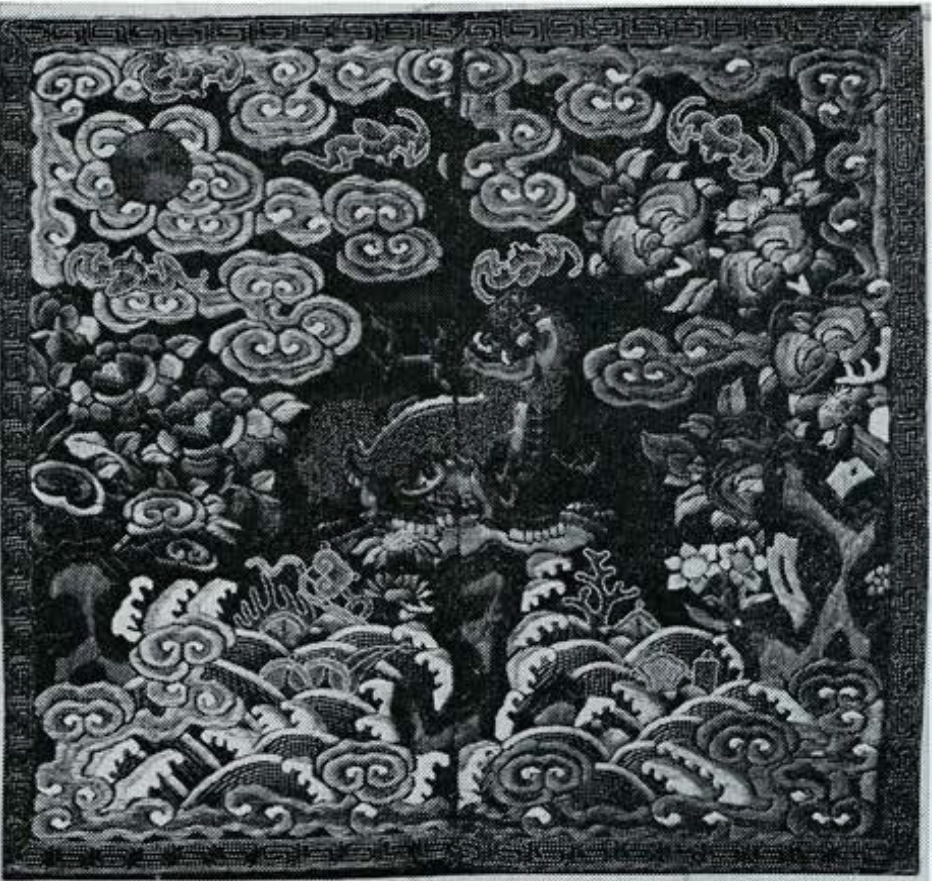
Museum Object Number: 52-23-72
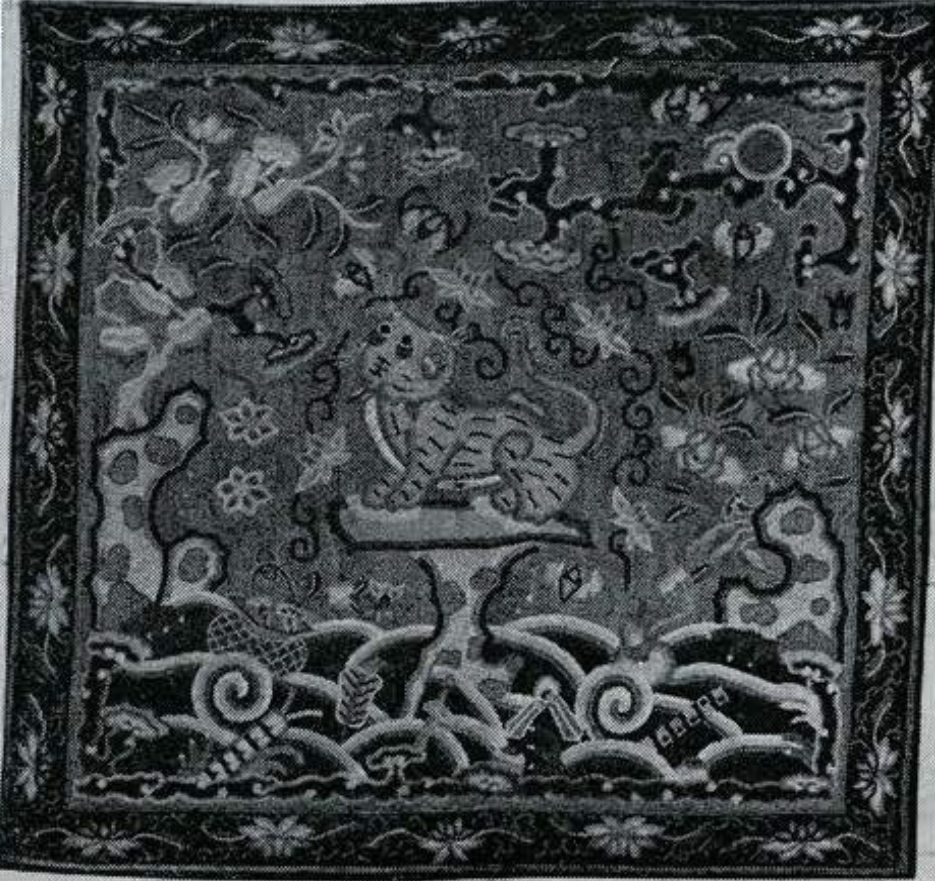
Museum Object Number: 52-23-78
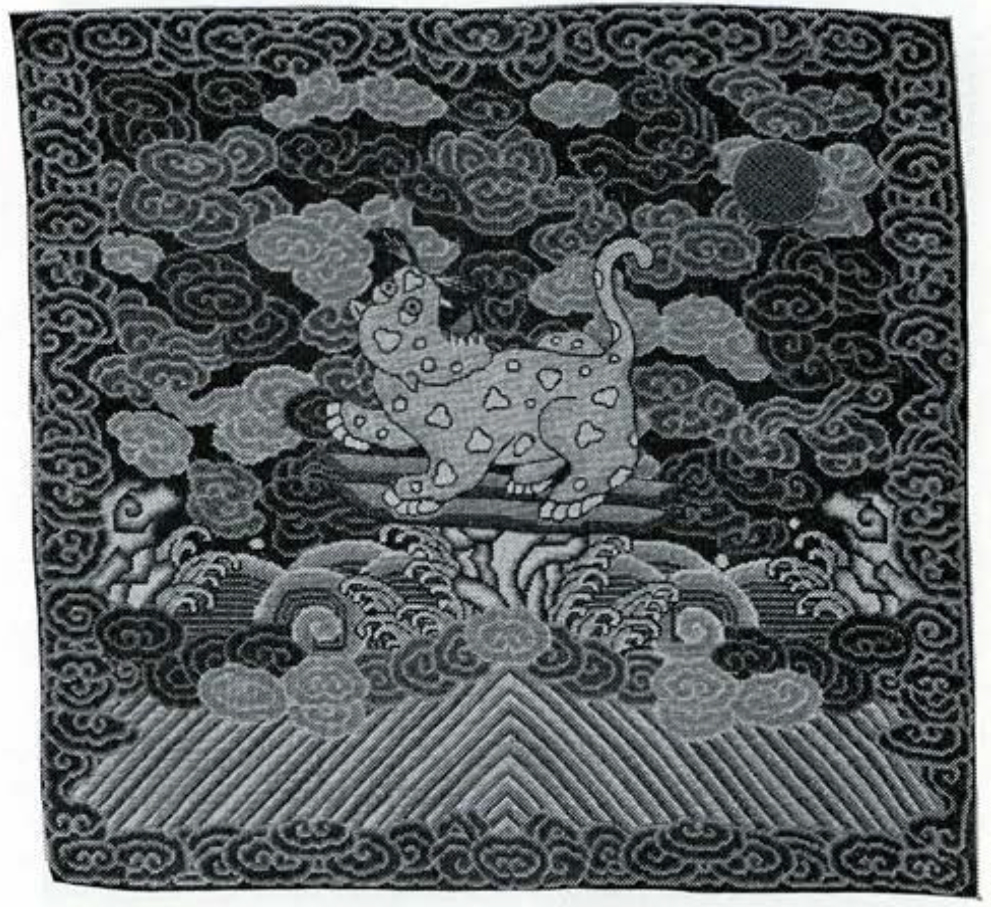
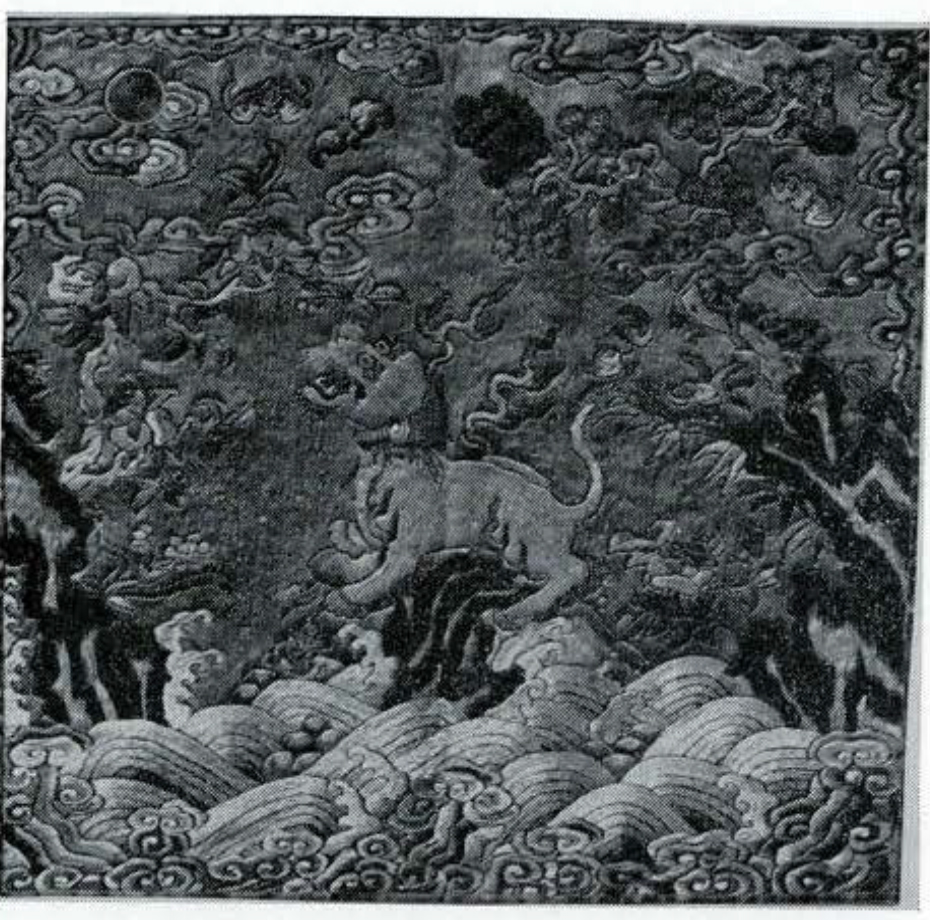
Museum Object Number: 52-23-93
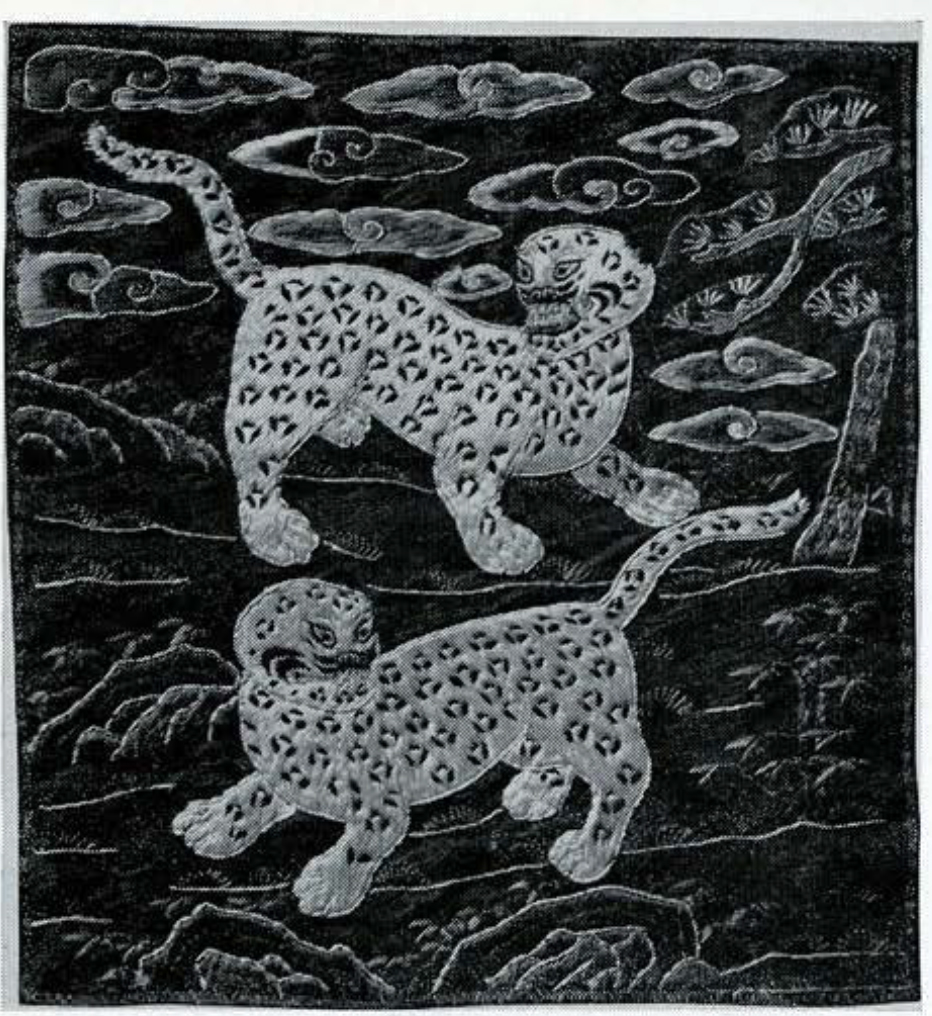
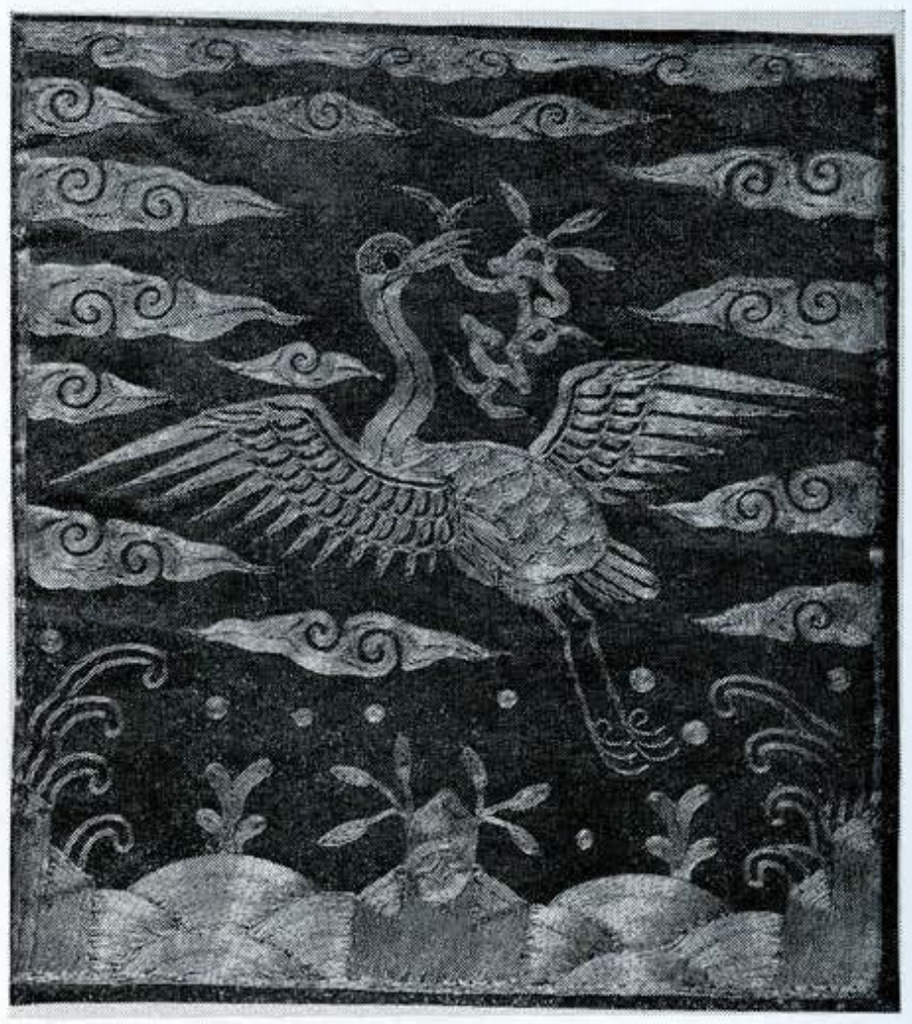
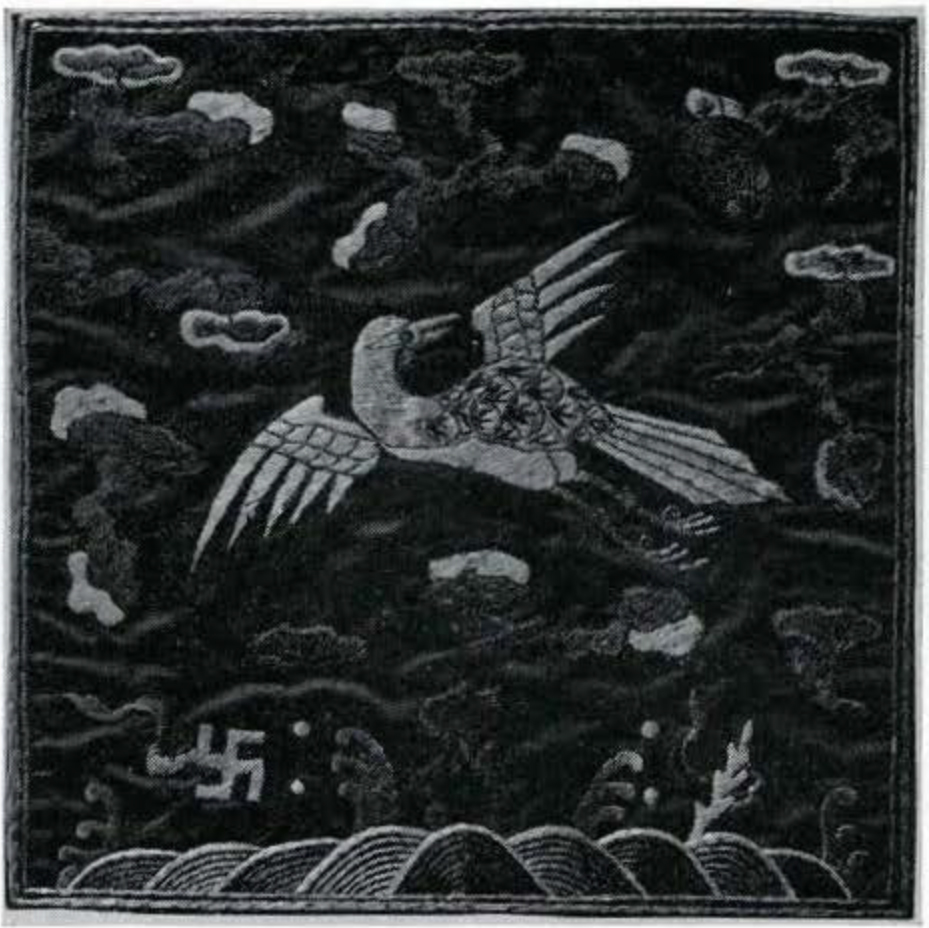
Museum Object Numbers: 52-23-62A / 52-23-62B
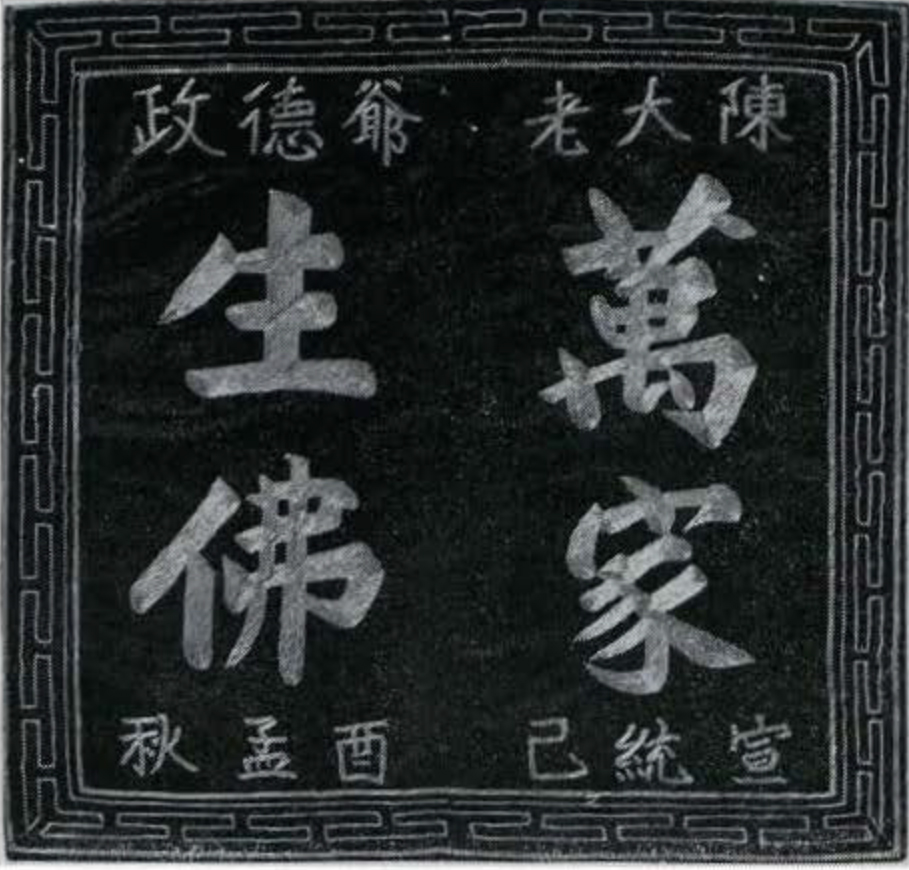
Museum Object Numbers: 52-23-96A / 52-23-96B
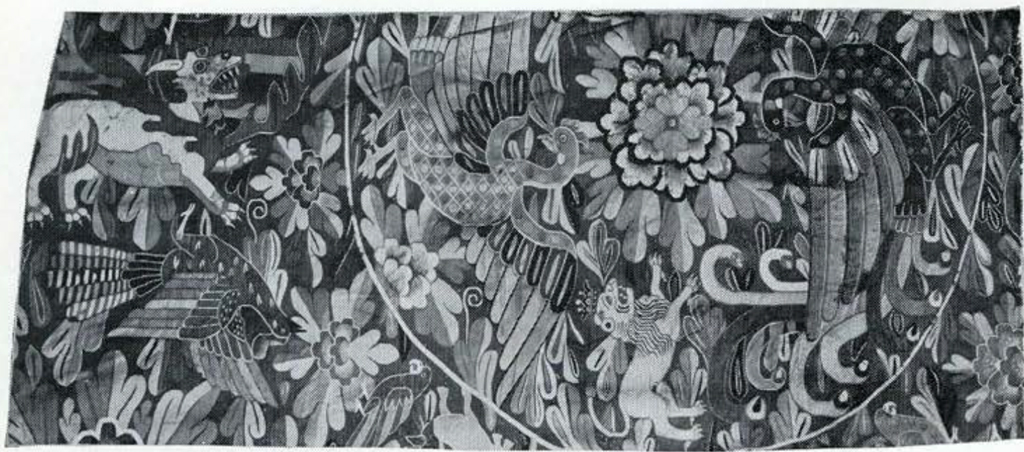
D. MIDDLE AND LATER CH’ING ANIMAL SQUARES
- Imperial Censor’s (or Judge’s) hsieh-chai squares (pair). Rather late k’o-ssu tapestry, with painted details, the background in fine gold. Archaistic pattern as on No. 21, from about the same period. Symbols: two bats, pines, peonies, fungus with bamboo; pavilion on left rock. Inner: border of paired k’uei-lung (dragons), thin outer line of gold. Early 19th cent. Museum Object Number: 52-23-63A / 52-23-63B
- Imperial Censor’s (or Judge’s) hsieh-chai square. In satin stitch on blue-black satin; mane, lines on back, and tail of couched silver tinsel thread wrapped in green silk to produce effect like peacock feathers; sun in stem satin stitch; waves in split satin stitch, a few Peking knots. (The characteristic horn and other details on the animal itself were apparently never completed). Symbol: five red bats, peonies and fungus, peaches and narcissus, jewels in waves. Greek fret border couched in gold. 19th cent. Museum Object Number: 52-23-64
- Hseih-chai square for wife of Censor (or Judge). Done in Peking knot on blue-black satin, except for couched wrapped metal threads on the animal’s mane and tail (as on the preceding example) and white couched outlines. Symbols: seven bats and over-conventionalized flowers. Border of paired k’uei-lung dragons flanking oblong shou characters, with three lotuses in the corners. Late19th cent. Museum Object Number: 52-23-65
- Hsieh-chai square for wife of Censor (or Judge). Done in couched white and colored twisted silk, and couched gold, on dark satin. Fine sculptural effect achieved by superimposing details. Symbols: three bats and many lucky peaches in the sky; jewels in the waves. Greek fret border in couched gold. Fine workmanship. 19th cent. Illustrated in Fig. 21. Museum Object Number: 52-23-66
- Imperial Censor’s (or Judge’s) hsieh-chai square. Very coarse Peking knot on blue-black satin, with couched gold outlines; pine needles of twisted silk in satin stitch to give variety. Symbols: three red bats and pine trees. Border of Greek fret couched in gold. (Originally this pattern was on a split front square, but it was transferred to a single piece of silk, so it now resembles a rear one). l9th cent. Museum Object Number: 52-23-67
- Imperial Censor’s (or Judge’s) hsieh-chai square. The animal, clouds, sun, and symbols are embroidered on gauze in a petit point technique, while the silver body of the animal and the gold background are intricately worked in threads of these precious metals in an odd form of overcasting. No rocks or sea, but the Eight Buddhist Symbols in background. (The animal soaring toward the sun, against the clouds, is equivalent to the flying birds on late Ch’ing squares). A late border of bats alternating with circular shot1 characters. 20th cent. Museum Object Number: 52-23-68
- Duke’s mang dragon squares (pair). Four-clawed dragon couched in gold and silver, with finely rendered scales, against a background of details in Florentine stitch; on gauze. Symbols: three red bats, the Eight Buddhist Symbols. Border of Greek fret couched in gold. 19th cent. Illustrated in Fig. 19. Museum Object Number: 52-23-69A / 52-23-69B
- First rank military officer’s ch’i-lin square. Peking stitch with couched gold outlines and tendril background; mane and tail of couched silver wire wrapped in green silk (like No. 64). Symbols: five bats, with a sixth added later apliqué (probably to fill a gap in the pattern where the gold had come loose); the Eight Buddhist Symbols; highly conventionalized peaches and narcissus. Li shui. A clumsy fret border in couched gold. 19th cent. Museum Object Number: 52-23-70
- First rank ch’i-lin square for officer’s wife. Mostly embroidered in satin stitch on blue-black satin; body has couched filling of twisted blue thread to create a scale effect; waves in split satin stitch; flower stems and other details in stem stitch; a few Peking knots; clumsy later embroidery in the upper corners to conceal damage. Symbols: peaches, peonies and fungus with bamboo; jewels in sea, along with three halberds in vase making a rebus (see No. 17) and an additional jade music stone to broaden the pun meaning. Early 19th cent. Illustrated in Fig. 22. Museum Object Number: 52-23-71
- Second rank military officer’s lion square. (Only the curls on the mane and back can identify these late Ch’ing lions from the blue form of the fifth rank bear). Done in rather coarse satin stitch on blue-black satin, with couched mane and tail on the animal (as on No. 64); waves in stem satin stitch; some of the symbols in Peking knot; masses outlined in couched white cord. Symbols: five red bats; peony and fungus, peaches and narcissus; and jewel symbols in sea. Greek fret border in couched gold. Late 19th cent. Illustrated in Fig. 23. Museum Object Number: 52-23-72
- Second rank military officer’s lion squares (pair). Soaring lion with ten bats in satin stitch; sun of silver threads couched with red silk; couched outlines of fine gold and silver thread. Border of alternating gold and silver shou characters. The lion looks too weird to have been worn on an official square, and it has late aniline dyes. Possibly this was made after the fall of the Ch’ing dynasty for an actor’s robe. 20th cent. Museum Object Number: 52-23-73A / 52-23-73B
- Third rank military officer’s leopard square. Animal, rocks, clouds and sea, in satin stitch on blue-black satin. Peking knot used for symbols; outlining in couched twisted white cord; split satin stitch for waves. Symbols: five red bats, peonies md fungus with bamboo, peaches and narcissus; the Eight Buddhist Symbols in the waves. Original border missing. 19th cent. Museum Object Number: 52-23-74
- Third rank military leopard square for officer’s wife. Late k’o-ssu with some aniline dyes, many details painted in; gold background for square proper and for the border. Symbols: five blue bats, the Eight Buddhist Symbols, blue flowers; peonies’, fungus clusters, and narcissus. Li shui. Fret border. Late 19th cent. Museum Object Number: 52-23-75
- Third rank military officer’s leopard square. In Peking knot, with outlines in couched white twisted cord, against a laid gold background. Symbols: five bats (four in red), fungus with bamboo and narcissus; the Eight Buddhist Symbols; and pearls. Border of Greek fret couched in gold. Late 19th cent. Museum Object Number: 52-23-76
- Third rank military officer’s leopard squares (pair). (The animal soaring through the clouds recalls the flying birds on contemporary late Ch’ing civil squares). Leopard couched in gold, with couched outlines of twisted blue silk; sun in stem satin stitch; clouds and symbols in plain satin stitch. Symbols: five green bats, the Eight Buddhist Symbols; three halberds and music stone in vase. Border of alternating gold bats and oblong shou characters in silver, couched between thin lines of gold. This square has the same general pattern as No. 39, except that the latter, being a woman’s square, has all the same symbols in reverse. They were not necessarily embroidered by the same artisan, but probably made in the same workshop; certainly from the same pattern (reversed). Early 20th cent. Museum Object Number: 52-23-77A / 52-23-77B
- Fourth rank military tiger square for officer’s wife. Entirely done in Peking knot, except for the animals, whiskers, eyelashes, and tail trimmings, lightly done in satin stitches. Animal framed in lotus flower on tendrils. Symbols: five bats; peaches and narcissus, peonies and fungus; the Eight Taoist Symbols, and pearls. Border of alternating blue and red lotus flowers. (Pattern almost identical with No. 33). 19th cent. Illustrated in Fig. 24. Museum Object Number: 52-23-78
- Fourth rank military tiger square for, officer’s wife. Satin stitch on blue-black split satin; split satin stitch for waves; stem satin stitch; star stitches for pine needles, and a few Peking knots. Symbols: one bat; pine tree, peach tree and peonies, fungus; jewels in sea. Border missing. Late 18th or early 19th cent. Museum Object Number: 52-23-79
- Fourth rank military officer’s tiger square. Mostly in Peking knot, with outlines couched in twisted white, blue and-silver cord, on blue-black satin. The tiger has obviously been added later in satin. stitch to replace an earlier animal (bear?), which was probably rendered in Peking knot like the rest- doubtless because of a sudden promotion for the owner. Symbols: five red bats; peonies and fungus with bamboo, peaches and narcissus; the Eight Buddhist Symbols, and pearls in the sea. Border of alternating reel bats and oblong shou characters. (Compare identical patterns on Nos. 20, 45, and 91). 19th cent. Museum Object Number: 52-23-80
- Fourth rank military officer’s tiger square. Peking knot with couched white outlines, on dark satin. Symbols: five red bats, fungus and narcissus; the Eight Buddhist Symbols, and pearls. Greek fret border. Late 19th cent. Museum Object Number: 52-23-81
- Fourth rank military officer’s tiger squares (pair). Couched gold on black satin. Symbols: fungus, bamboo and narcissus; vase with three halberds and music stone, together with other lucky emblems. Border of a continuous ju-i pattern. Early 20th cent. Museum Object Number: 52-23-82A / 52-23-82B
- Fifth rank military officer’s bear square. Mostly in coarse satin stitch on blue-black cloth; animal has couched mane and tail (like No. 64); symbols done in Peking knot. Symbols: five red bats; peony and fungus with bamboo; peaches and narcissus; ten kinds of jewel symbols. Greek fret border couched in gold. (This square is identical in pattern with No. 72, and could have been made by the same person. These two squares, Nos. 83 and 72, neatly show the small contrast between bear and lion on the late Ch’ing squares: body form, coloring and tails practically the same, only real difference being in more curls on the lion). 19th cent. Museum Object Number: 52-23-83
- Fifth rank military bear square for official’s wife. Animal mostly couched in gold; other details in satin stitch, outlined in couched gold; on blue-black satin. Small sun and rudimentary li shui. Symbols: a red bat and pine tree, jewels in sea. Inner border of continuous clouds, outer one which was probably a line of gold, now missing. Mid-18th cent. Museum Object Number: 52-23-84
- Fifth rank military officer’s bear square. Satin stitch, except for couched outlines and trimmings on animal; waves in split satin stitch; pine needles in star stitch. Very small sun. Symbols: pine tree, fungus, and mallow flowers (?). 18th century type. Museum Object Number: 52-23-85
- Fifth rank military officer’s bear square. Animal couched in gold, with details, and the entire background in satin stitch; waves in split satin stitch. Small sun, arching waves, rudimentary li shui, no symbols. Early 18th cent. Museum Object Number: 52-23-86
- Fifth rank military officer’s bear squares (pair). Satin stitch on blue-black satin; waves in split satin stitch; a few Poking knots in the flowers. As a variation on the bear, the animal is whitish instead of blue, but bas the usual shape. Symbols: five red bats, peonies and fungus with bamboo, peaches and narcissus, jewels in sea. Greek fret border. 19th cent. Museum Object Number: 52-23-87A / 52-23-87B
- Fifth rank military bear squares for official’s wife (pair). Late k’o-ssu with much paint, very coarse tarnished gold thread background. Symbols: two bats; the eight symbols of the Taoist Immortals. and the Eight Jewels in the sky; the Eight Buddhist Symbols in the waves; and over-conventionalized flowers. Li shui. Border of continuous swastikas. Late 19th or early 20th cent. Museum Object Number: 52-23-88A / 52-23-88B
- Fifth rank military officer’s bear squares (pair). Rather coarse satin stitch on blue-black satin; bear (of same general type as that on No. 83, but having less well-shaped head) has couched gold mane and tail (like No. 64). Symbols: five red bats, peonies and fungus with bamboo, peaches and narcissus, jewel symbols in sea. Couched border in Greek fret. (Identical in pattern with No. 64, and al· most the same as No. 87). Museum Object Number: 52-23-89A / 52-23-89B
- Fifth rank military officer’s bear square. In satin stitch, with couched mane and tail (like No. 64); bats and other symbols in Peking knot, outlined in twisted white cord; on blue-black satin. Symbols: live bats, peonies and fungus with bamboo, peaches and narcissus, jewels in waves. Original border gone. (Has same general pattern as No. 83, but this looks a little earlier; this might have served as the model for No. 83, or more likely, the maker of each used the same pattern as a model). 19th cent. Museum Object Number: 52-23-90
- Fifth rank military officer’s bear squares (pair). Peking knot, on blue-black satin, with couched outlines in thin white cord. Tbe scanty mane and tail are couched like No. 64. Symbols: five red bats; peonies and fungus with bamboo, peaches, narcissus; the Eight Buddhist Symbols, and jewels in sea. Border of alternating bats and oblong shou characters. (Compare identical patterns on Nos. 20, 45 and 80). 19th cent. Museum Object Number: 52-23-91A / 52-23-91B
- Fifth rank military officer’s bear squares (pair). Peking knot on blue-black satin. Symbols: eight blue bats, over-conventionalized flowers and leaves, with jewel symbols in waves. Border of paired k’uei-lung (dragons) with circular shou character between each pair, bats in corners. 19th cent. Museum Object Number: 52-23-92B
- Fifth rank military officer’s bear square. In satin stitch, with pink background of same (resembling No. 57, this was probably also made for use on a mourning robe). The whitish form of the bear, instead of the more usual blue one. Symbols: three red bats, peaches and narcissus, peony, fungus with bamboo, and pine tree; jewels in sea. Simple key fret border. Early 19th cent. Illustrated in Fig. 26. Museum Object Number: 52-23-93
- Fifth rank military bear square for officer’s wife. Peking knot on blue-black satin. Symbols: three red bats, lotus flowers on tendrils in sky; narcissus and fungus at sides; jewels in sea. Border of alternate red and blue lotus flowers. 19th cent. Museum Object Number: 52-23-94
- Fifth rank military bear square for officer’s wife. Very late k’o-ssu, seemingly a poor copy of No. 88, with identical details. An example of cultural degeneration at the end of the Ch’ing dynasty. Early 20th cent. Museum Object Number: 52-23-95
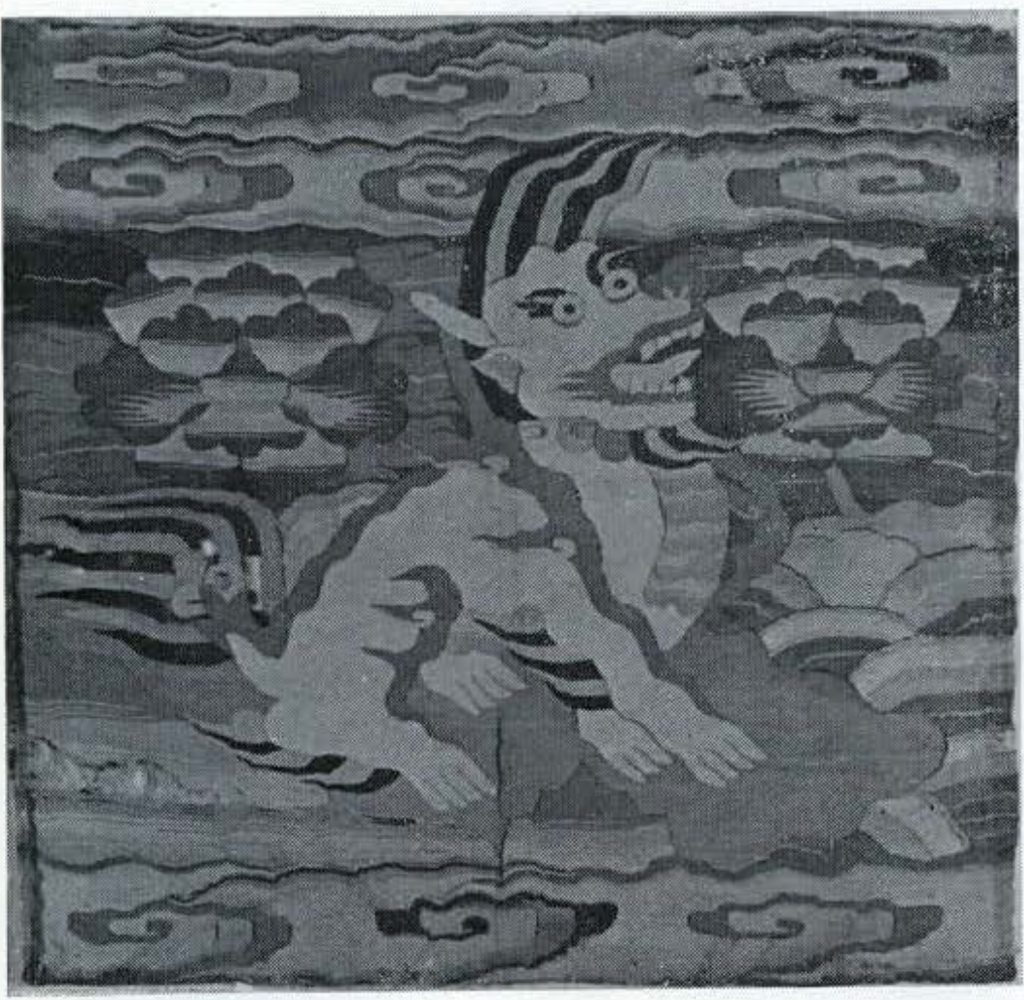
E. MISCELLANEOUS TYPES OF SQUARES
- Presentation squares (wan-ming p’u), presented to the Hon. Mr. Ch’en in the autumn of 1909, by the merchants and citizens of Pi-chou (Pi-yi) in Honan, according to the inscriptions, as a parting gift on the occasion of his leaving for another post. Four very large characters on each say: “The Living Buddha of ten thousand families,” and “May your entire journey be under a happy star.” In couched silver on blue-black satin. Probably actually worn on his departure, because the front square is stained by rain or tears. Illustrated in Fig. 30. Museum Object Number: 52-23-96A / 52-23-96B
- Ornamental square plaque from the back of a Chinese Buddhist (or Lamaist) priest’s cope, portraying a conventionalized Buddha figure seated on a lotus. The face and hands are done in satin stitch; rest of pattern in gold couching; on red satin. The basic pattern, including li shui, is obviously derived from the later Ch’ing squares, probably after the fall of the dynasty. This does not belong among the mandarin squares proper, but it shows well how the basic form was sometimes put to other uses. Museum Object Number: 52-23-97
In addition the collection has a number of other sets of embroidered squares which do not belong in the direct mandarin square tradition. Most of them show oddly conventionalized cranes on a red silk background, and seem to belong to the “funeral squares” category. Others seem to be wedding squares. Too little is yet known about these less orthodox categories to assign them precisely, but they are valuable for comparative study.




